Overview of Accounting Financial Analysis
VerifiedAdded on 2022/08/12
|25
|4270
|32
AI Summary
Contribute Materials
Your contribution can guide someone’s learning journey. Share your
documents today.
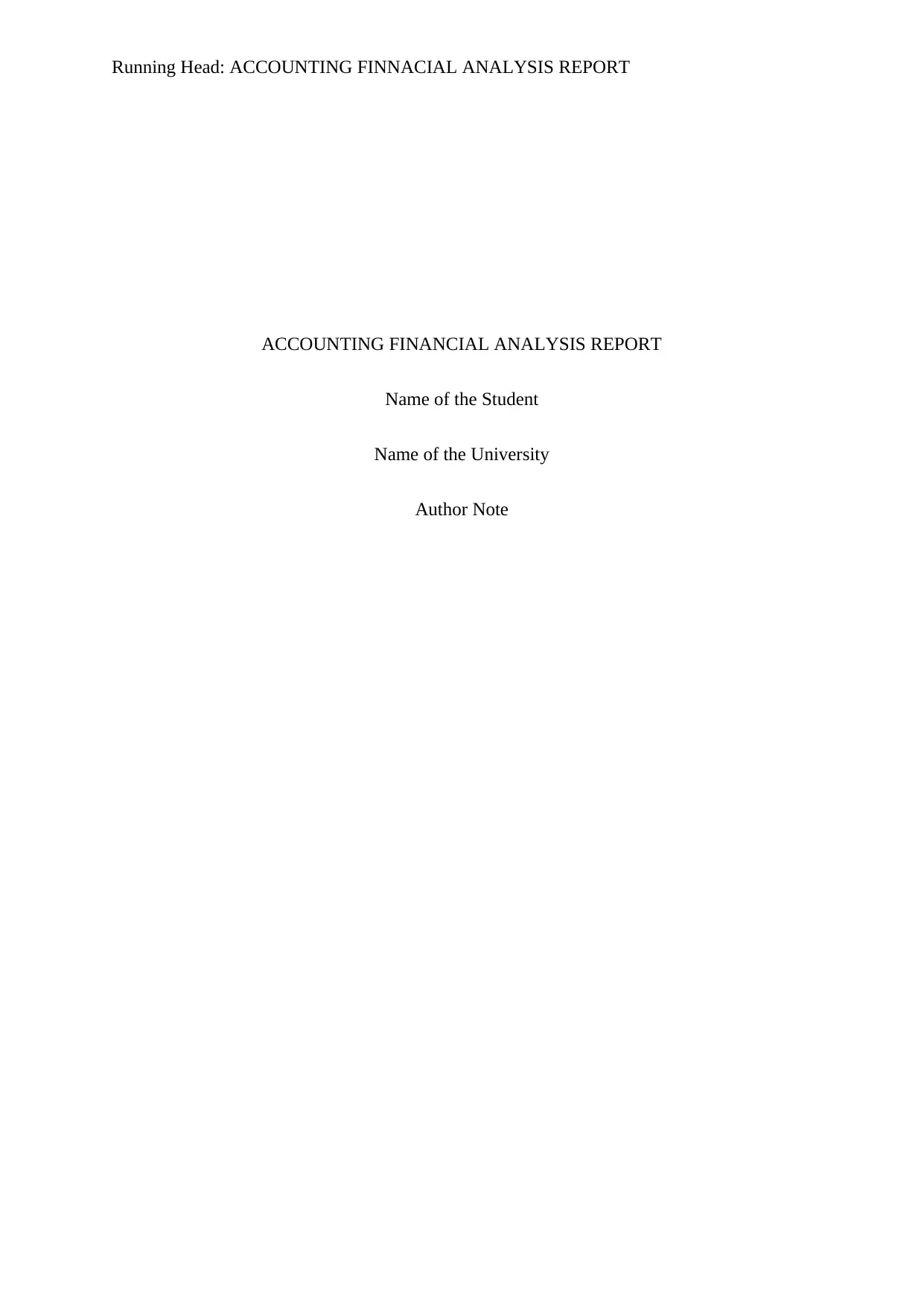
Running Head: ACCOUNTING FINNACIAL ANALYSIS REPORT
ACCOUNTING FINANCIAL ANALYSIS REPORT
Name of the Student
Name of the University
Author Note
ACCOUNTING FINANCIAL ANALYSIS REPORT
Name of the Student
Name of the University
Author Note
Secure Best Marks with AI Grader
Need help grading? Try our AI Grader for instant feedback on your assignments.
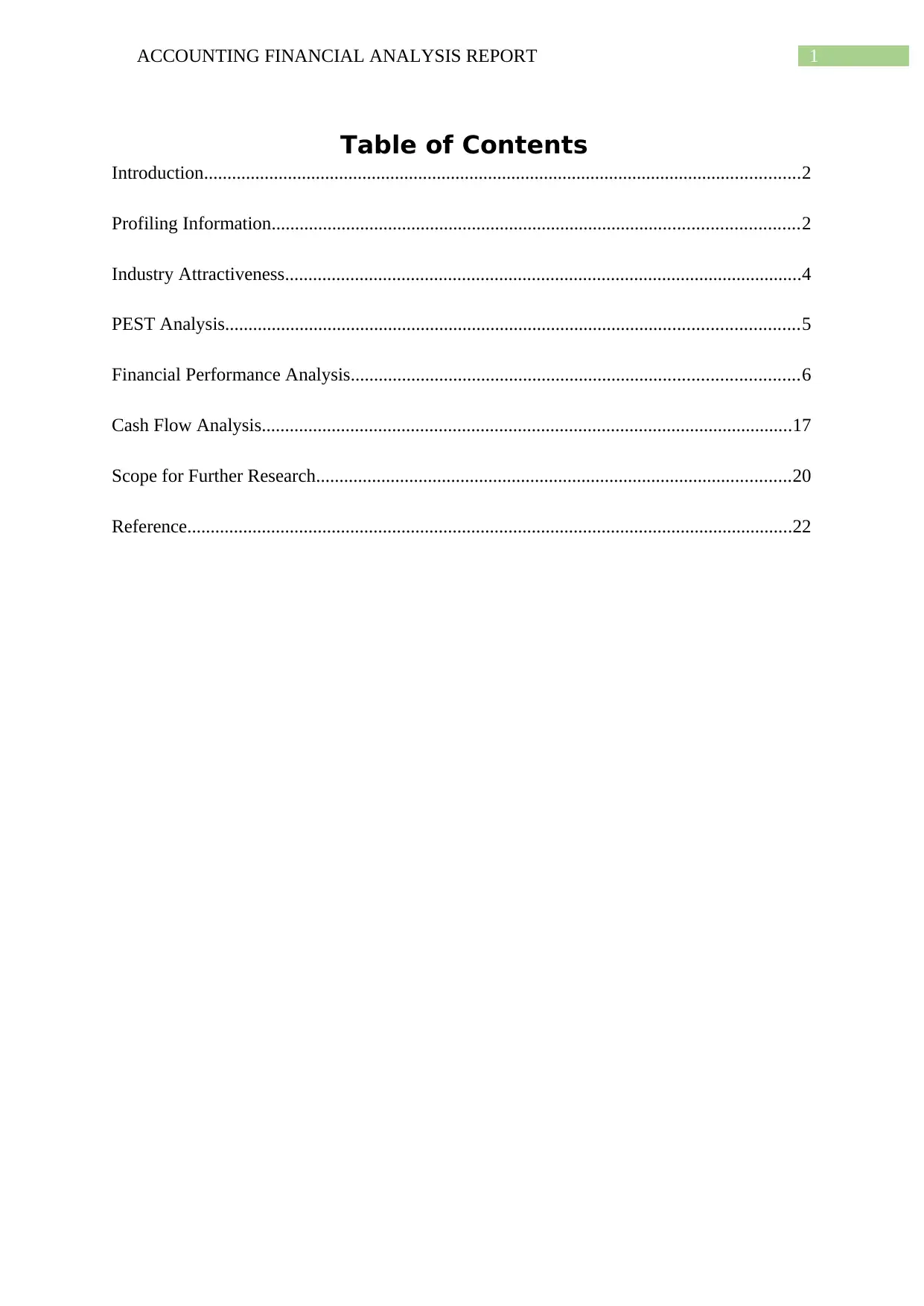
1ACCOUNTING FINANCIAL ANALYSIS REPORT
Table of Contents
Introduction................................................................................................................................2
Profiling Information.................................................................................................................2
Industry Attractiveness...............................................................................................................4
PEST Analysis...........................................................................................................................5
Financial Performance Analysis................................................................................................6
Cash Flow Analysis..................................................................................................................17
Scope for Further Research......................................................................................................20
Reference..................................................................................................................................22
Table of Contents
Introduction................................................................................................................................2
Profiling Information.................................................................................................................2
Industry Attractiveness...............................................................................................................4
PEST Analysis...........................................................................................................................5
Financial Performance Analysis................................................................................................6
Cash Flow Analysis..................................................................................................................17
Scope for Further Research......................................................................................................20
Reference..................................................................................................................................22
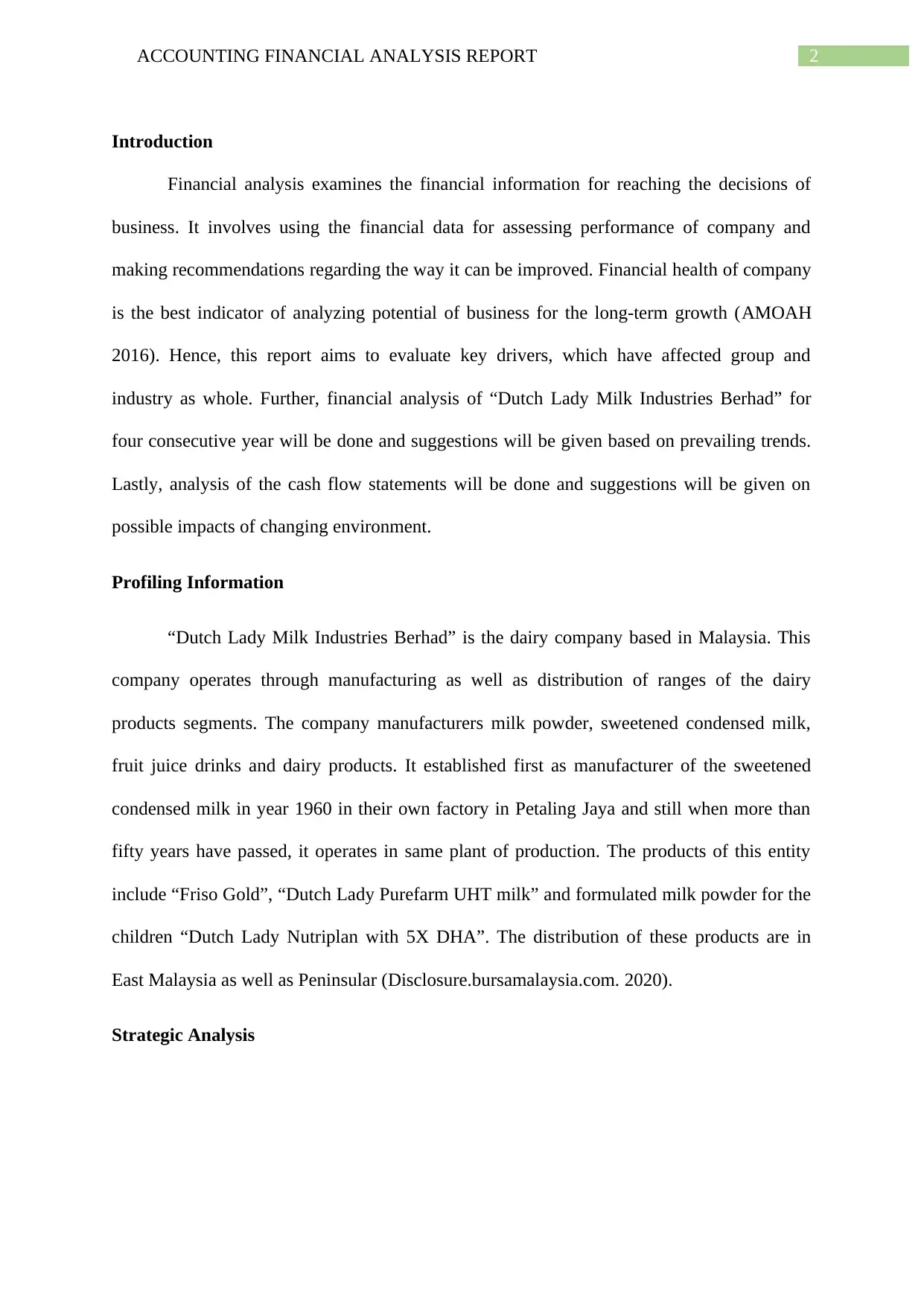
2ACCOUNTING FINANCIAL ANALYSIS REPORT
Introduction
Financial analysis examines the financial information for reaching the decisions of
business. It involves using the financial data for assessing performance of company and
making recommendations regarding the way it can be improved. Financial health of company
is the best indicator of analyzing potential of business for the long-term growth (AMOAH
2016). Hence, this report aims to evaluate key drivers, which have affected group and
industry as whole. Further, financial analysis of “Dutch Lady Milk Industries Berhad” for
four consecutive year will be done and suggestions will be given based on prevailing trends.
Lastly, analysis of the cash flow statements will be done and suggestions will be given on
possible impacts of changing environment.
Profiling Information
“Dutch Lady Milk Industries Berhad” is the dairy company based in Malaysia. This
company operates through manufacturing as well as distribution of ranges of the dairy
products segments. The company manufacturers milk powder, sweetened condensed milk,
fruit juice drinks and dairy products. It established first as manufacturer of the sweetened
condensed milk in year 1960 in their own factory in Petaling Jaya and still when more than
fifty years have passed, it operates in same plant of production. The products of this entity
include “Friso Gold”, “Dutch Lady Purefarm UHT milk” and formulated milk powder for the
children “Dutch Lady Nutriplan with 5X DHA”. The distribution of these products are in
East Malaysia as well as Peninsular (Disclosure.bursamalaysia.com. 2020).
Strategic Analysis
Introduction
Financial analysis examines the financial information for reaching the decisions of
business. It involves using the financial data for assessing performance of company and
making recommendations regarding the way it can be improved. Financial health of company
is the best indicator of analyzing potential of business for the long-term growth (AMOAH
2016). Hence, this report aims to evaluate key drivers, which have affected group and
industry as whole. Further, financial analysis of “Dutch Lady Milk Industries Berhad” for
four consecutive year will be done and suggestions will be given based on prevailing trends.
Lastly, analysis of the cash flow statements will be done and suggestions will be given on
possible impacts of changing environment.
Profiling Information
“Dutch Lady Milk Industries Berhad” is the dairy company based in Malaysia. This
company operates through manufacturing as well as distribution of ranges of the dairy
products segments. The company manufacturers milk powder, sweetened condensed milk,
fruit juice drinks and dairy products. It established first as manufacturer of the sweetened
condensed milk in year 1960 in their own factory in Petaling Jaya and still when more than
fifty years have passed, it operates in same plant of production. The products of this entity
include “Friso Gold”, “Dutch Lady Purefarm UHT milk” and formulated milk powder for the
children “Dutch Lady Nutriplan with 5X DHA”. The distribution of these products are in
East Malaysia as well as Peninsular (Disclosure.bursamalaysia.com. 2020).
Strategic Analysis
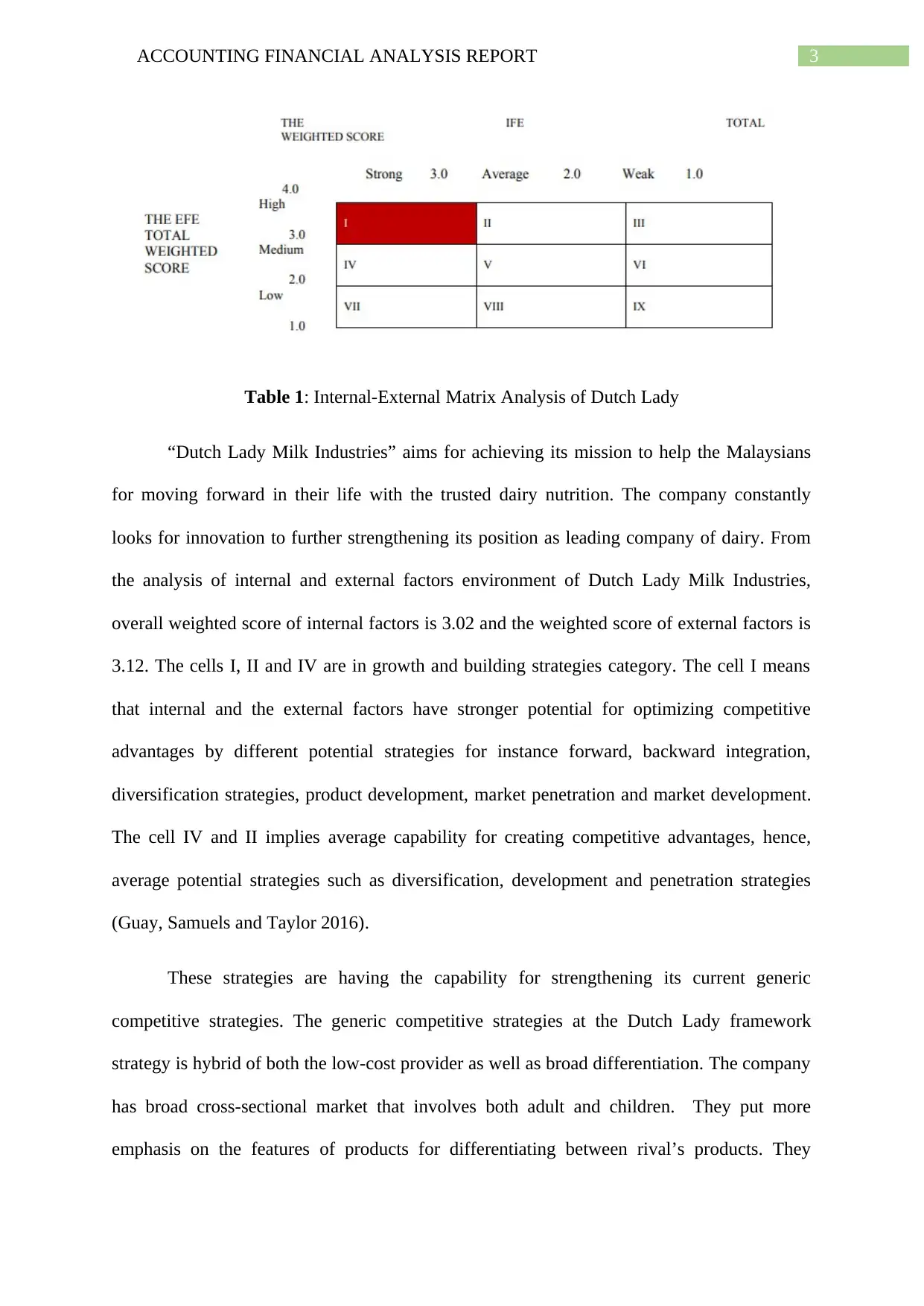
3ACCOUNTING FINANCIAL ANALYSIS REPORT
Table 1: Internal-External Matrix Analysis of Dutch Lady
“Dutch Lady Milk Industries” aims for achieving its mission to help the Malaysians
for moving forward in their life with the trusted dairy nutrition. The company constantly
looks for innovation to further strengthening its position as leading company of dairy. From
the analysis of internal and external factors environment of Dutch Lady Milk Industries,
overall weighted score of internal factors is 3.02 and the weighted score of external factors is
3.12. The cells I, II and IV are in growth and building strategies category. The cell I means
that internal and the external factors have stronger potential for optimizing competitive
advantages by different potential strategies for instance forward, backward integration,
diversification strategies, product development, market penetration and market development.
The cell IV and II implies average capability for creating competitive advantages, hence,
average potential strategies such as diversification, development and penetration strategies
(Guay, Samuels and Taylor 2016).
These strategies are having the capability for strengthening its current generic
competitive strategies. The generic competitive strategies at the Dutch Lady framework
strategy is hybrid of both the low-cost provider as well as broad differentiation. The company
has broad cross-sectional market that involves both adult and children. They put more
emphasis on the features of products for differentiating between rival’s products. They
Table 1: Internal-External Matrix Analysis of Dutch Lady
“Dutch Lady Milk Industries” aims for achieving its mission to help the Malaysians
for moving forward in their life with the trusted dairy nutrition. The company constantly
looks for innovation to further strengthening its position as leading company of dairy. From
the analysis of internal and external factors environment of Dutch Lady Milk Industries,
overall weighted score of internal factors is 3.02 and the weighted score of external factors is
3.12. The cells I, II and IV are in growth and building strategies category. The cell I means
that internal and the external factors have stronger potential for optimizing competitive
advantages by different potential strategies for instance forward, backward integration,
diversification strategies, product development, market penetration and market development.
The cell IV and II implies average capability for creating competitive advantages, hence,
average potential strategies such as diversification, development and penetration strategies
(Guay, Samuels and Taylor 2016).
These strategies are having the capability for strengthening its current generic
competitive strategies. The generic competitive strategies at the Dutch Lady framework
strategy is hybrid of both the low-cost provider as well as broad differentiation. The company
has broad cross-sectional market that involves both adult and children. They put more
emphasis on the features of products for differentiating between rival’s products. They
Secure Best Marks with AI Grader
Need help grading? Try our AI Grader for instant feedback on your assignments.
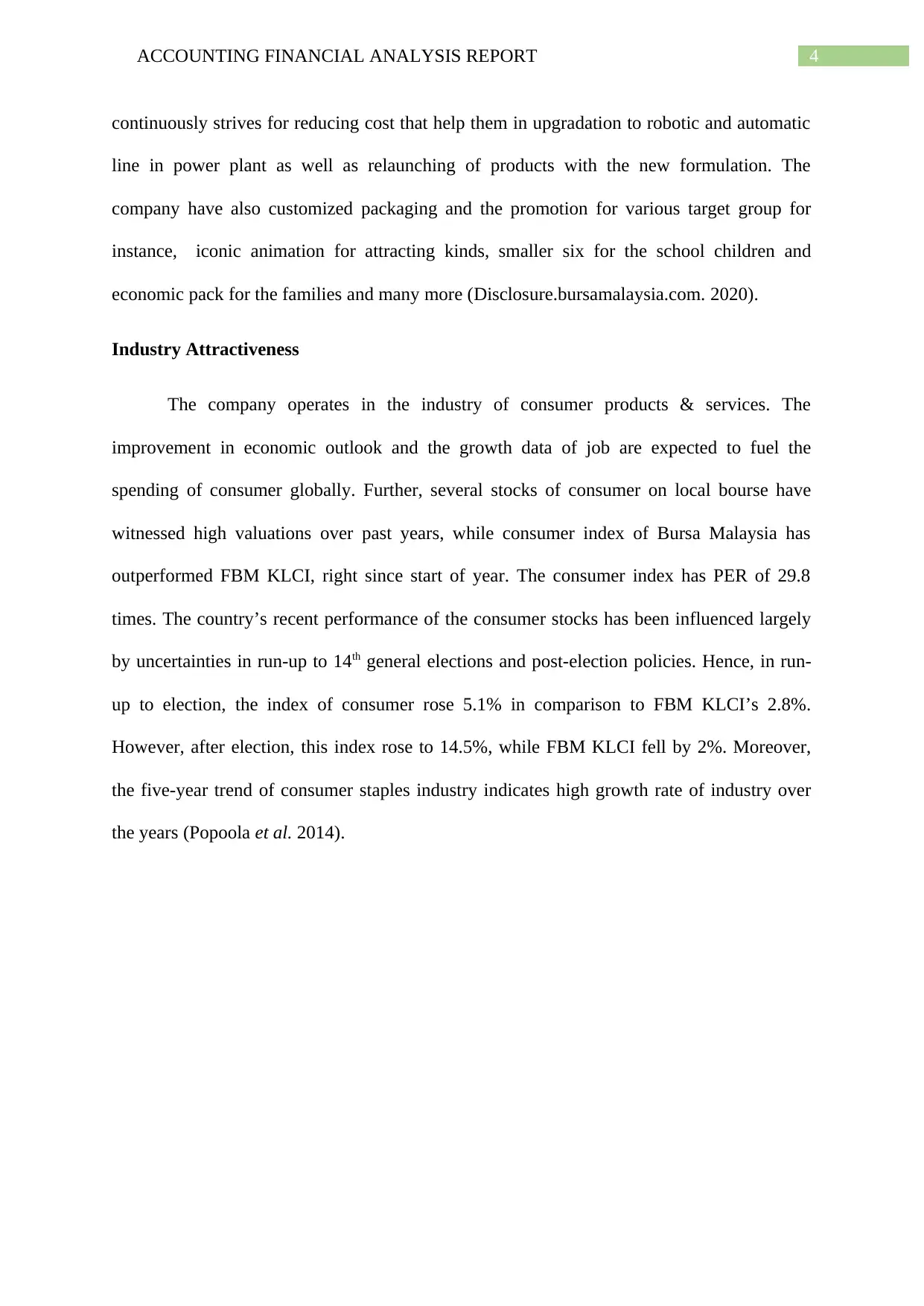
4ACCOUNTING FINANCIAL ANALYSIS REPORT
continuously strives for reducing cost that help them in upgradation to robotic and automatic
line in power plant as well as relaunching of products with the new formulation. The
company have also customized packaging and the promotion for various target group for
instance, iconic animation for attracting kinds, smaller six for the school children and
economic pack for the families and many more (Disclosure.bursamalaysia.com. 2020).
Industry Attractiveness
The company operates in the industry of consumer products & services. The
improvement in economic outlook and the growth data of job are expected to fuel the
spending of consumer globally. Further, several stocks of consumer on local bourse have
witnessed high valuations over past years, while consumer index of Bursa Malaysia has
outperformed FBM KLCI, right since start of year. The consumer index has PER of 29.8
times. The country’s recent performance of the consumer stocks has been influenced largely
by uncertainties in run-up to 14th general elections and post-election policies. Hence, in run-
up to election, the index of consumer rose 5.1% in comparison to FBM KLCI’s 2.8%.
However, after election, this index rose to 14.5%, while FBM KLCI fell by 2%. Moreover,
the five-year trend of consumer staples industry indicates high growth rate of industry over
the years (Popoola et al. 2014).
continuously strives for reducing cost that help them in upgradation to robotic and automatic
line in power plant as well as relaunching of products with the new formulation. The
company have also customized packaging and the promotion for various target group for
instance, iconic animation for attracting kinds, smaller six for the school children and
economic pack for the families and many more (Disclosure.bursamalaysia.com. 2020).
Industry Attractiveness
The company operates in the industry of consumer products & services. The
improvement in economic outlook and the growth data of job are expected to fuel the
spending of consumer globally. Further, several stocks of consumer on local bourse have
witnessed high valuations over past years, while consumer index of Bursa Malaysia has
outperformed FBM KLCI, right since start of year. The consumer index has PER of 29.8
times. The country’s recent performance of the consumer stocks has been influenced largely
by uncertainties in run-up to 14th general elections and post-election policies. Hence, in run-
up to election, the index of consumer rose 5.1% in comparison to FBM KLCI’s 2.8%.
However, after election, this index rose to 14.5%, while FBM KLCI fell by 2%. Moreover,
the five-year trend of consumer staples industry indicates high growth rate of industry over
the years (Popoola et al. 2014).
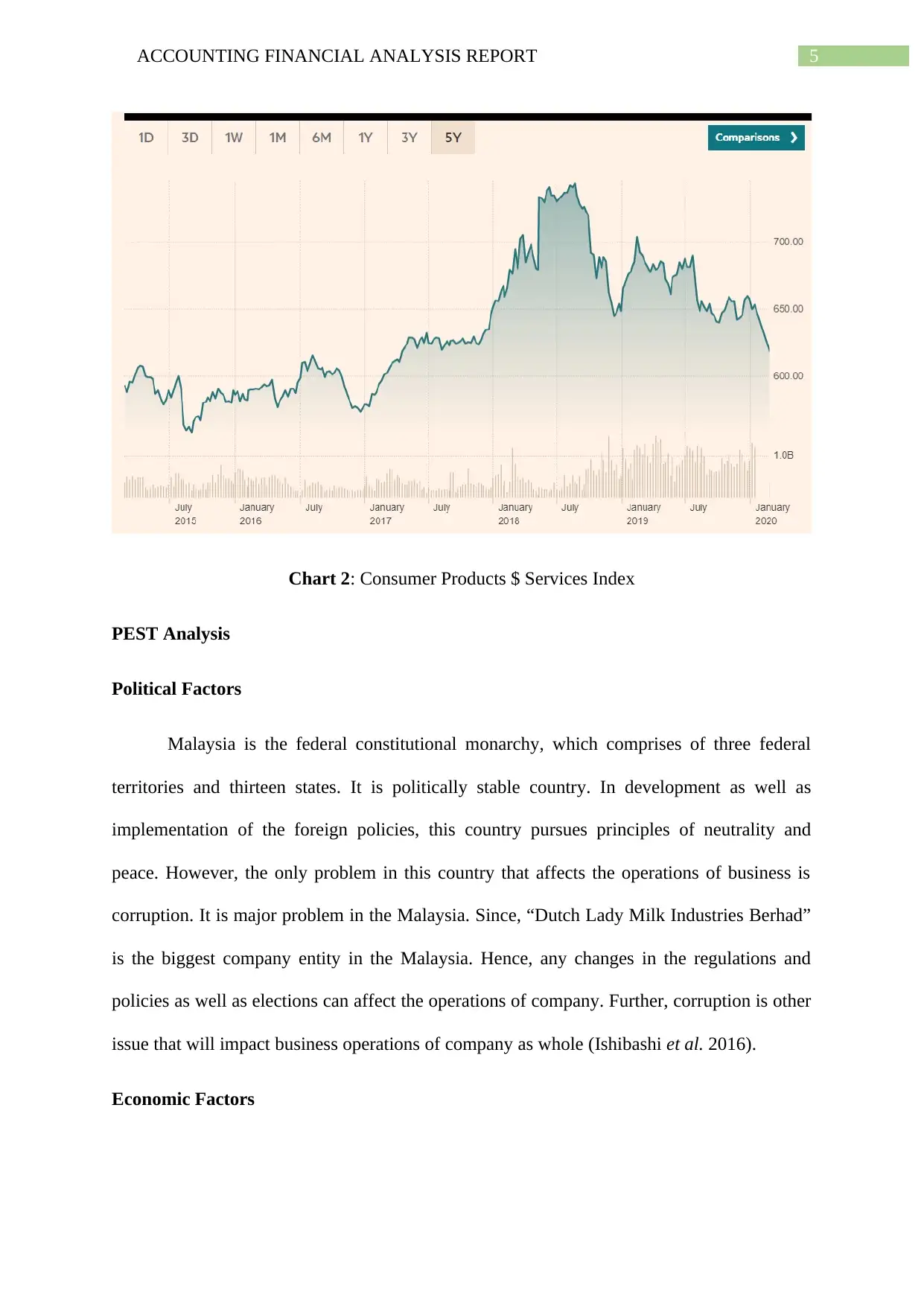
5ACCOUNTING FINANCIAL ANALYSIS REPORT
Chart 2: Consumer Products $ Services Index
PEST Analysis
Political Factors
Malaysia is the federal constitutional monarchy, which comprises of three federal
territories and thirteen states. It is politically stable country. In development as well as
implementation of the foreign policies, this country pursues principles of neutrality and
peace. However, the only problem in this country that affects the operations of business is
corruption. It is major problem in the Malaysia. Since, “Dutch Lady Milk Industries Berhad”
is the biggest company entity in the Malaysia. Hence, any changes in the regulations and
policies as well as elections can affect the operations of company. Further, corruption is other
issue that will impact business operations of company as whole (Ishibashi et al. 2016).
Economic Factors
Chart 2: Consumer Products $ Services Index
PEST Analysis
Political Factors
Malaysia is the federal constitutional monarchy, which comprises of three federal
territories and thirteen states. It is politically stable country. In development as well as
implementation of the foreign policies, this country pursues principles of neutrality and
peace. However, the only problem in this country that affects the operations of business is
corruption. It is major problem in the Malaysia. Since, “Dutch Lady Milk Industries Berhad”
is the biggest company entity in the Malaysia. Hence, any changes in the regulations and
policies as well as elections can affect the operations of company. Further, corruption is other
issue that will impact business operations of company as whole (Ishibashi et al. 2016).
Economic Factors
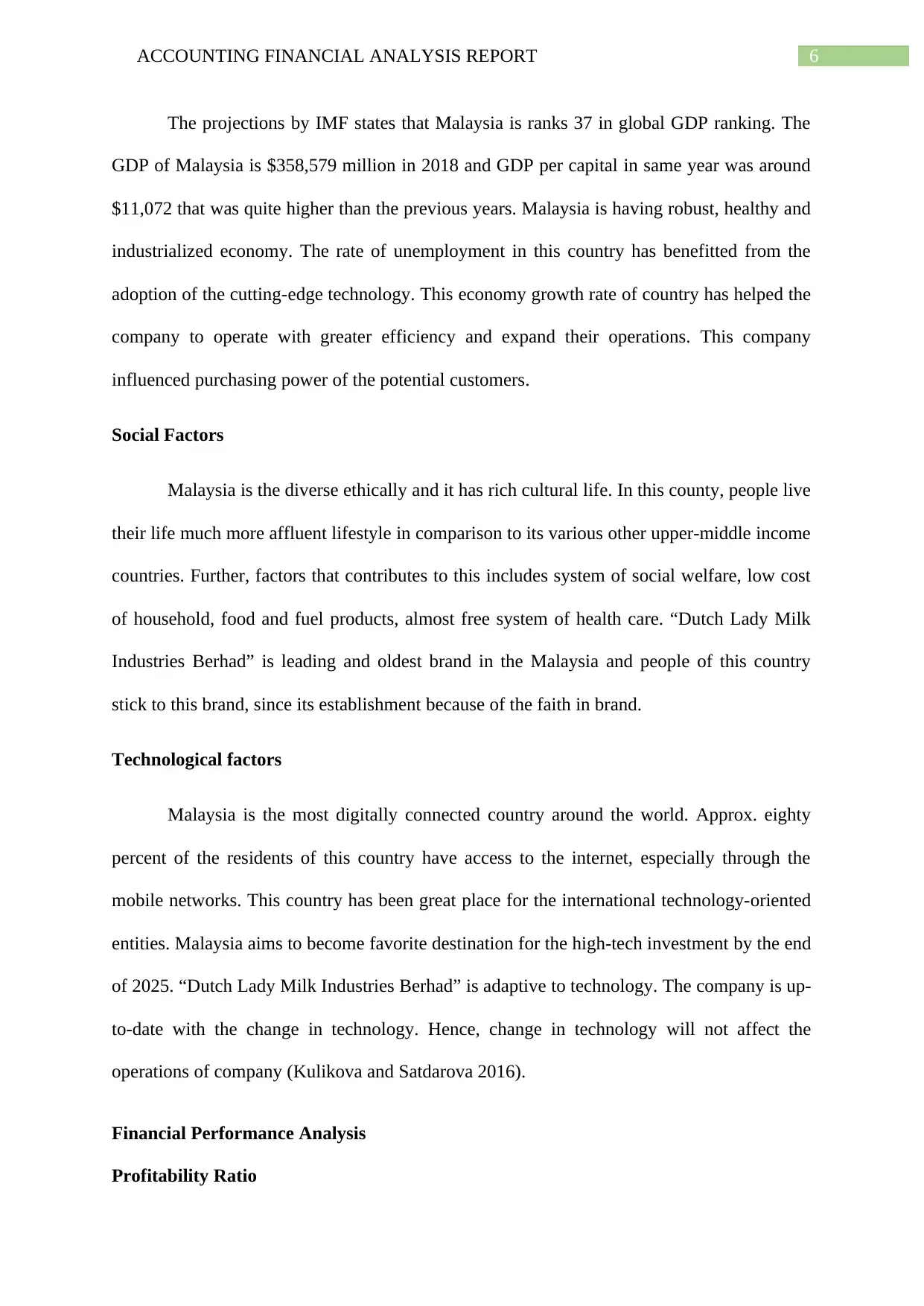
6ACCOUNTING FINANCIAL ANALYSIS REPORT
The projections by IMF states that Malaysia is ranks 37 in global GDP ranking. The
GDP of Malaysia is $358,579 million in 2018 and GDP per capital in same year was around
$11,072 that was quite higher than the previous years. Malaysia is having robust, healthy and
industrialized economy. The rate of unemployment in this country has benefitted from the
adoption of the cutting-edge technology. This economy growth rate of country has helped the
company to operate with greater efficiency and expand their operations. This company
influenced purchasing power of the potential customers.
Social Factors
Malaysia is the diverse ethically and it has rich cultural life. In this county, people live
their life much more affluent lifestyle in comparison to its various other upper-middle income
countries. Further, factors that contributes to this includes system of social welfare, low cost
of household, food and fuel products, almost free system of health care. “Dutch Lady Milk
Industries Berhad” is leading and oldest brand in the Malaysia and people of this country
stick to this brand, since its establishment because of the faith in brand.
Technological factors
Malaysia is the most digitally connected country around the world. Approx. eighty
percent of the residents of this country have access to the internet, especially through the
mobile networks. This country has been great place for the international technology-oriented
entities. Malaysia aims to become favorite destination for the high-tech investment by the end
of 2025. “Dutch Lady Milk Industries Berhad” is adaptive to technology. The company is up-
to-date with the change in technology. Hence, change in technology will not affect the
operations of company (Kulikova and Satdarova 2016).
Financial Performance Analysis
Profitability Ratio
The projections by IMF states that Malaysia is ranks 37 in global GDP ranking. The
GDP of Malaysia is $358,579 million in 2018 and GDP per capital in same year was around
$11,072 that was quite higher than the previous years. Malaysia is having robust, healthy and
industrialized economy. The rate of unemployment in this country has benefitted from the
adoption of the cutting-edge technology. This economy growth rate of country has helped the
company to operate with greater efficiency and expand their operations. This company
influenced purchasing power of the potential customers.
Social Factors
Malaysia is the diverse ethically and it has rich cultural life. In this county, people live
their life much more affluent lifestyle in comparison to its various other upper-middle income
countries. Further, factors that contributes to this includes system of social welfare, low cost
of household, food and fuel products, almost free system of health care. “Dutch Lady Milk
Industries Berhad” is leading and oldest brand in the Malaysia and people of this country
stick to this brand, since its establishment because of the faith in brand.
Technological factors
Malaysia is the most digitally connected country around the world. Approx. eighty
percent of the residents of this country have access to the internet, especially through the
mobile networks. This country has been great place for the international technology-oriented
entities. Malaysia aims to become favorite destination for the high-tech investment by the end
of 2025. “Dutch Lady Milk Industries Berhad” is adaptive to technology. The company is up-
to-date with the change in technology. Hence, change in technology will not affect the
operations of company (Kulikova and Satdarova 2016).
Financial Performance Analysis
Profitability Ratio
Paraphrase This Document
Need a fresh take? Get an instant paraphrase of this document with our AI Paraphraser
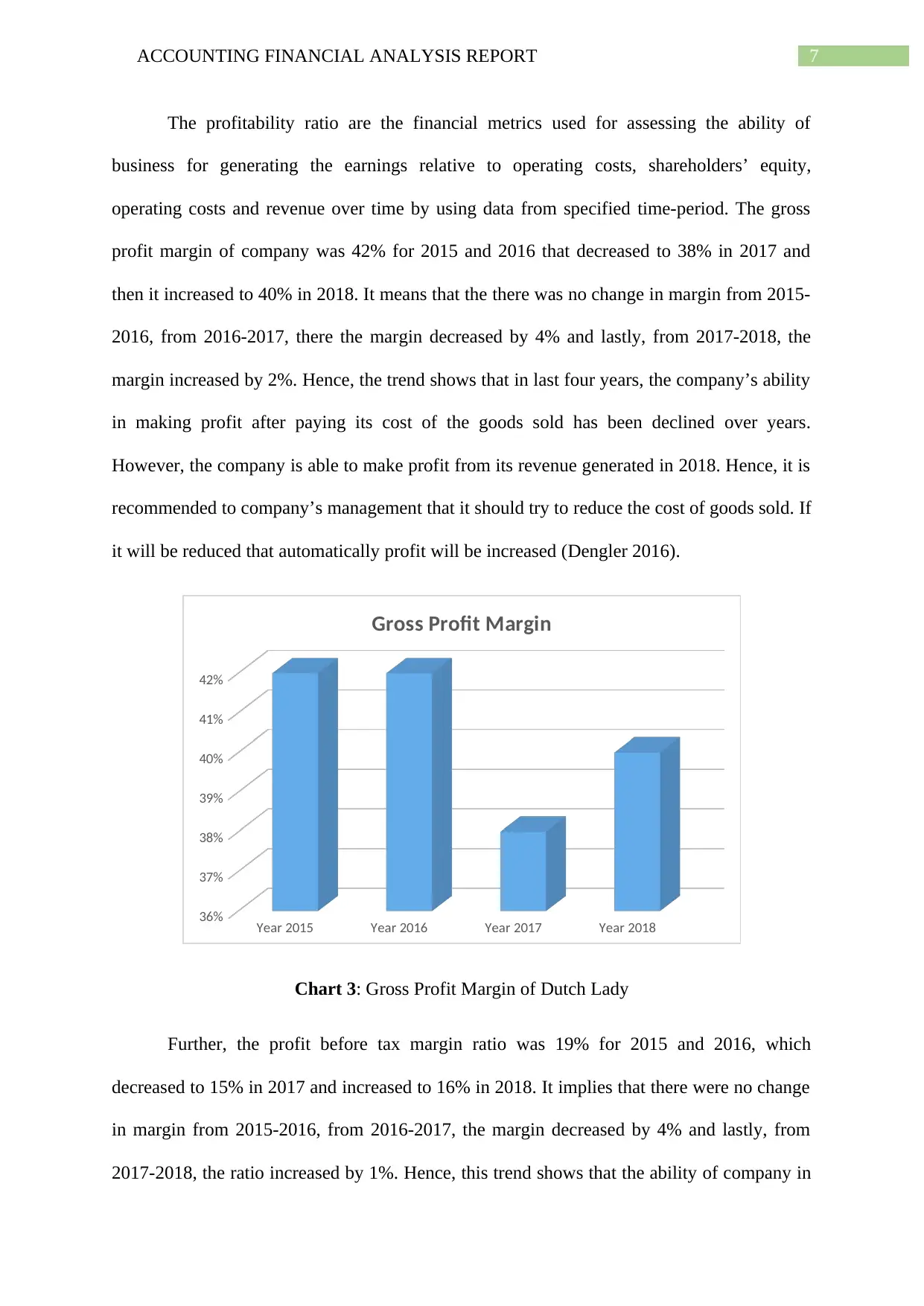
7ACCOUNTING FINANCIAL ANALYSIS REPORT
The profitability ratio are the financial metrics used for assessing the ability of
business for generating the earnings relative to operating costs, shareholders’ equity,
operating costs and revenue over time by using data from specified time-period. The gross
profit margin of company was 42% for 2015 and 2016 that decreased to 38% in 2017 and
then it increased to 40% in 2018. It means that the there was no change in margin from 2015-
2016, from 2016-2017, there the margin decreased by 4% and lastly, from 2017-2018, the
margin increased by 2%. Hence, the trend shows that in last four years, the company’s ability
in making profit after paying its cost of the goods sold has been declined over years.
However, the company is able to make profit from its revenue generated in 2018. Hence, it is
recommended to company’s management that it should try to reduce the cost of goods sold. If
it will be reduced that automatically profit will be increased (Dengler 2016).
Year 2015 Year 2016 Year 2017 Year 2018
36%
37%
38%
39%
40%
41%
42%
Gross Profit Margin
Chart 3: Gross Profit Margin of Dutch Lady
Further, the profit before tax margin ratio was 19% for 2015 and 2016, which
decreased to 15% in 2017 and increased to 16% in 2018. It implies that there were no change
in margin from 2015-2016, from 2016-2017, the margin decreased by 4% and lastly, from
2017-2018, the ratio increased by 1%. Hence, this trend shows that the ability of company in
The profitability ratio are the financial metrics used for assessing the ability of
business for generating the earnings relative to operating costs, shareholders’ equity,
operating costs and revenue over time by using data from specified time-period. The gross
profit margin of company was 42% for 2015 and 2016 that decreased to 38% in 2017 and
then it increased to 40% in 2018. It means that the there was no change in margin from 2015-
2016, from 2016-2017, there the margin decreased by 4% and lastly, from 2017-2018, the
margin increased by 2%. Hence, the trend shows that in last four years, the company’s ability
in making profit after paying its cost of the goods sold has been declined over years.
However, the company is able to make profit from its revenue generated in 2018. Hence, it is
recommended to company’s management that it should try to reduce the cost of goods sold. If
it will be reduced that automatically profit will be increased (Dengler 2016).
Year 2015 Year 2016 Year 2017 Year 2018
36%
37%
38%
39%
40%
41%
42%
Gross Profit Margin
Chart 3: Gross Profit Margin of Dutch Lady
Further, the profit before tax margin ratio was 19% for 2015 and 2016, which
decreased to 15% in 2017 and increased to 16% in 2018. It implies that there were no change
in margin from 2015-2016, from 2016-2017, the margin decreased by 4% and lastly, from
2017-2018, the ratio increased by 1%. Hence, this trend shows that the ability of company in
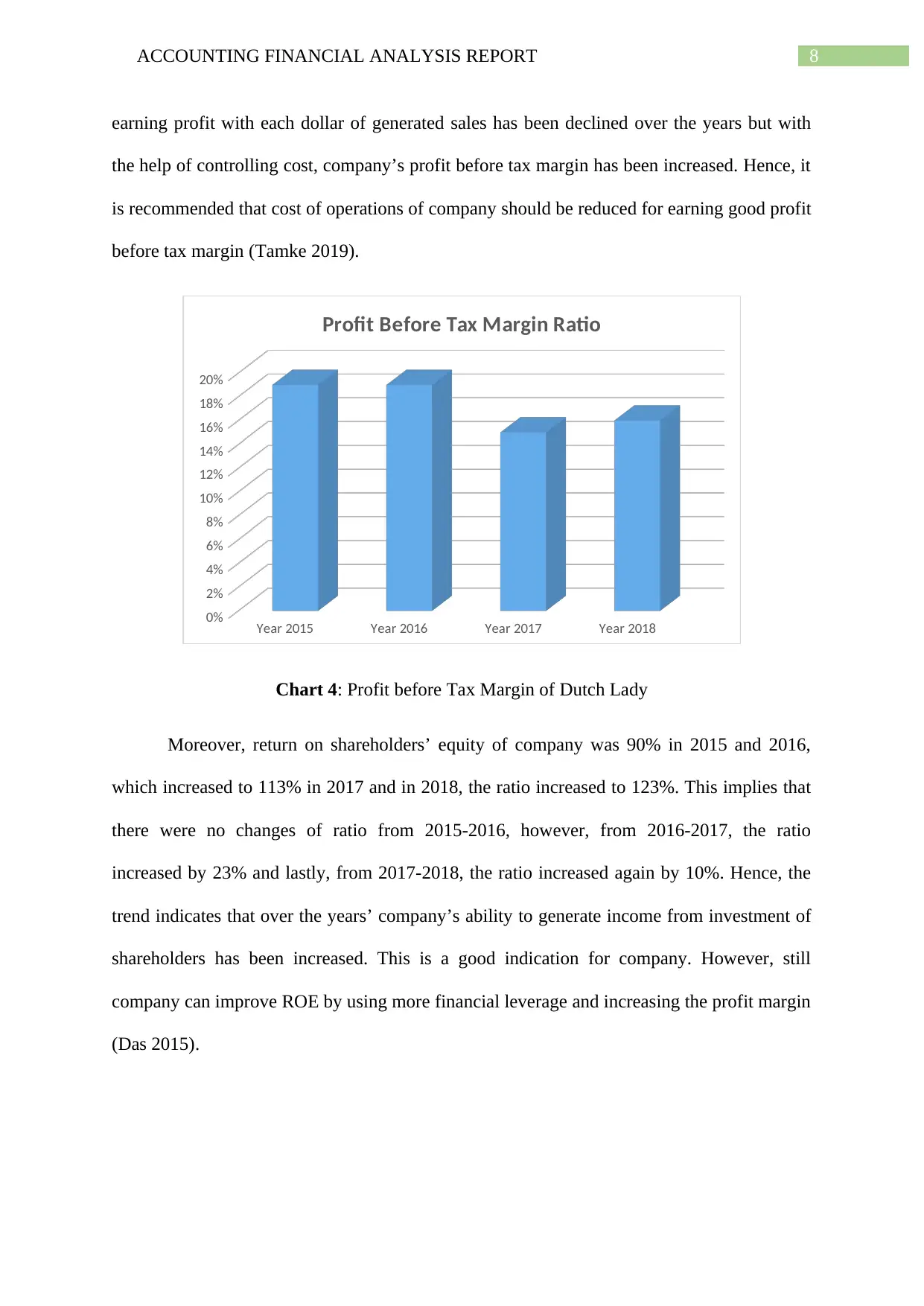
8ACCOUNTING FINANCIAL ANALYSIS REPORT
earning profit with each dollar of generated sales has been declined over the years but with
the help of controlling cost, company’s profit before tax margin has been increased. Hence, it
is recommended that cost of operations of company should be reduced for earning good profit
before tax margin (Tamke 2019).
Year 2015 Year 2016 Year 2017 Year 2018
0%
2%
4%
6%
8%
10%
12%
14%
16%
18%
20%
Profit Before Tax Margin Ratio
Chart 4: Profit before Tax Margin of Dutch Lady
Moreover, return on shareholders’ equity of company was 90% in 2015 and 2016,
which increased to 113% in 2017 and in 2018, the ratio increased to 123%. This implies that
there were no changes of ratio from 2015-2016, however, from 2016-2017, the ratio
increased by 23% and lastly, from 2017-2018, the ratio increased again by 10%. Hence, the
trend indicates that over the years’ company’s ability to generate income from investment of
shareholders has been increased. This is a good indication for company. However, still
company can improve ROE by using more financial leverage and increasing the profit margin
(Das 2015).
earning profit with each dollar of generated sales has been declined over the years but with
the help of controlling cost, company’s profit before tax margin has been increased. Hence, it
is recommended that cost of operations of company should be reduced for earning good profit
before tax margin (Tamke 2019).
Year 2015 Year 2016 Year 2017 Year 2018
0%
2%
4%
6%
8%
10%
12%
14%
16%
18%
20%
Profit Before Tax Margin Ratio
Chart 4: Profit before Tax Margin of Dutch Lady
Moreover, return on shareholders’ equity of company was 90% in 2015 and 2016,
which increased to 113% in 2017 and in 2018, the ratio increased to 123%. This implies that
there were no changes of ratio from 2015-2016, however, from 2016-2017, the ratio
increased by 23% and lastly, from 2017-2018, the ratio increased again by 10%. Hence, the
trend indicates that over the years’ company’s ability to generate income from investment of
shareholders has been increased. This is a good indication for company. However, still
company can improve ROE by using more financial leverage and increasing the profit margin
(Das 2015).
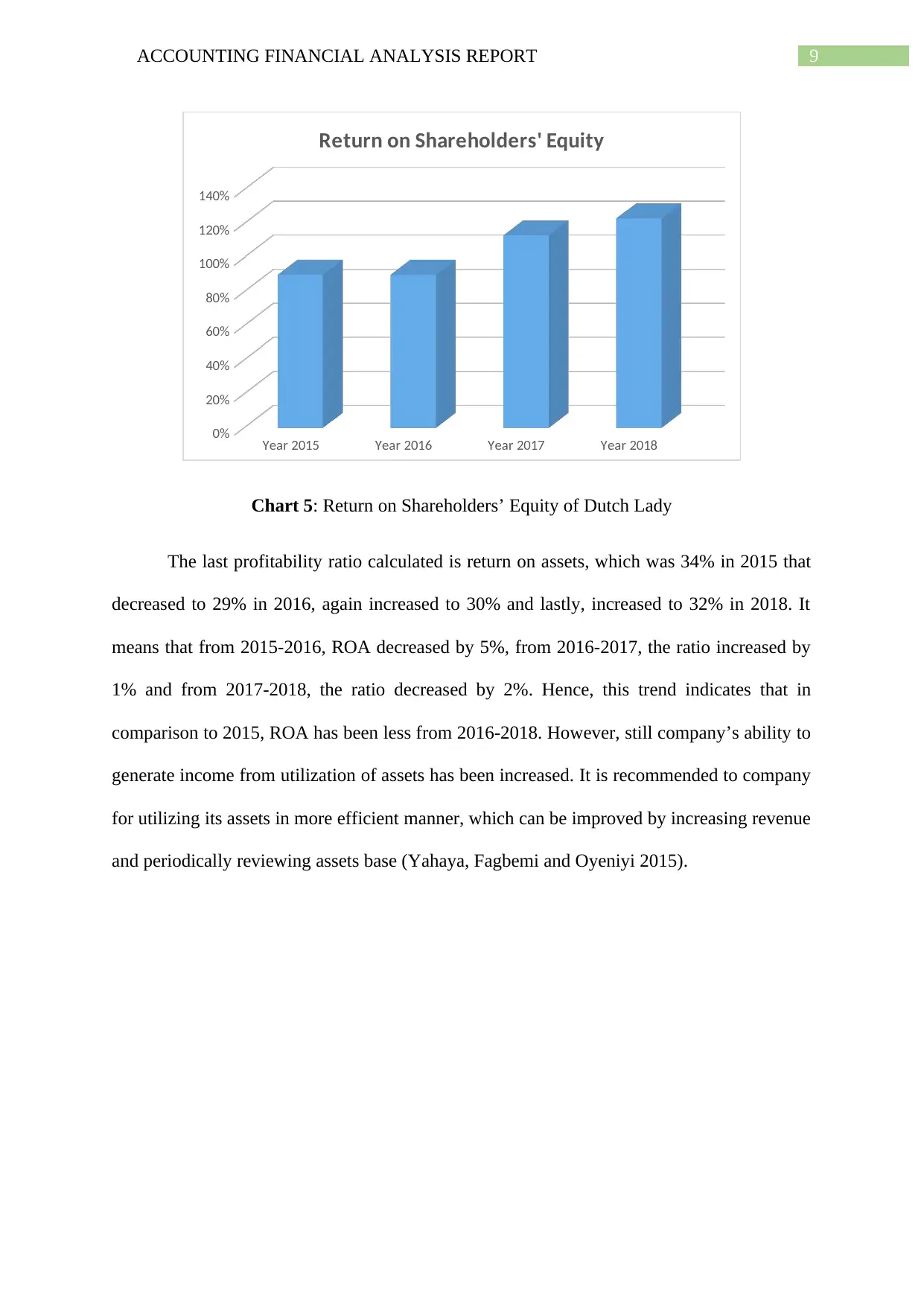
9ACCOUNTING FINANCIAL ANALYSIS REPORT
Year 2015 Year 2016 Year 2017 Year 2018
0%
20%
40%
60%
80%
100%
120%
140%
Return on Shareholders' Equity
Chart 5: Return on Shareholders’ Equity of Dutch Lady
The last profitability ratio calculated is return on assets, which was 34% in 2015 that
decreased to 29% in 2016, again increased to 30% and lastly, increased to 32% in 2018. It
means that from 2015-2016, ROA decreased by 5%, from 2016-2017, the ratio increased by
1% and from 2017-2018, the ratio decreased by 2%. Hence, this trend indicates that in
comparison to 2015, ROA has been less from 2016-2018. However, still company’s ability to
generate income from utilization of assets has been increased. It is recommended to company
for utilizing its assets in more efficient manner, which can be improved by increasing revenue
and periodically reviewing assets base (Yahaya, Fagbemi and Oyeniyi 2015).
Year 2015 Year 2016 Year 2017 Year 2018
0%
20%
40%
60%
80%
100%
120%
140%
Return on Shareholders' Equity
Chart 5: Return on Shareholders’ Equity of Dutch Lady
The last profitability ratio calculated is return on assets, which was 34% in 2015 that
decreased to 29% in 2016, again increased to 30% and lastly, increased to 32% in 2018. It
means that from 2015-2016, ROA decreased by 5%, from 2016-2017, the ratio increased by
1% and from 2017-2018, the ratio decreased by 2%. Hence, this trend indicates that in
comparison to 2015, ROA has been less from 2016-2018. However, still company’s ability to
generate income from utilization of assets has been increased. It is recommended to company
for utilizing its assets in more efficient manner, which can be improved by increasing revenue
and periodically reviewing assets base (Yahaya, Fagbemi and Oyeniyi 2015).
Secure Best Marks with AI Grader
Need help grading? Try our AI Grader for instant feedback on your assignments.
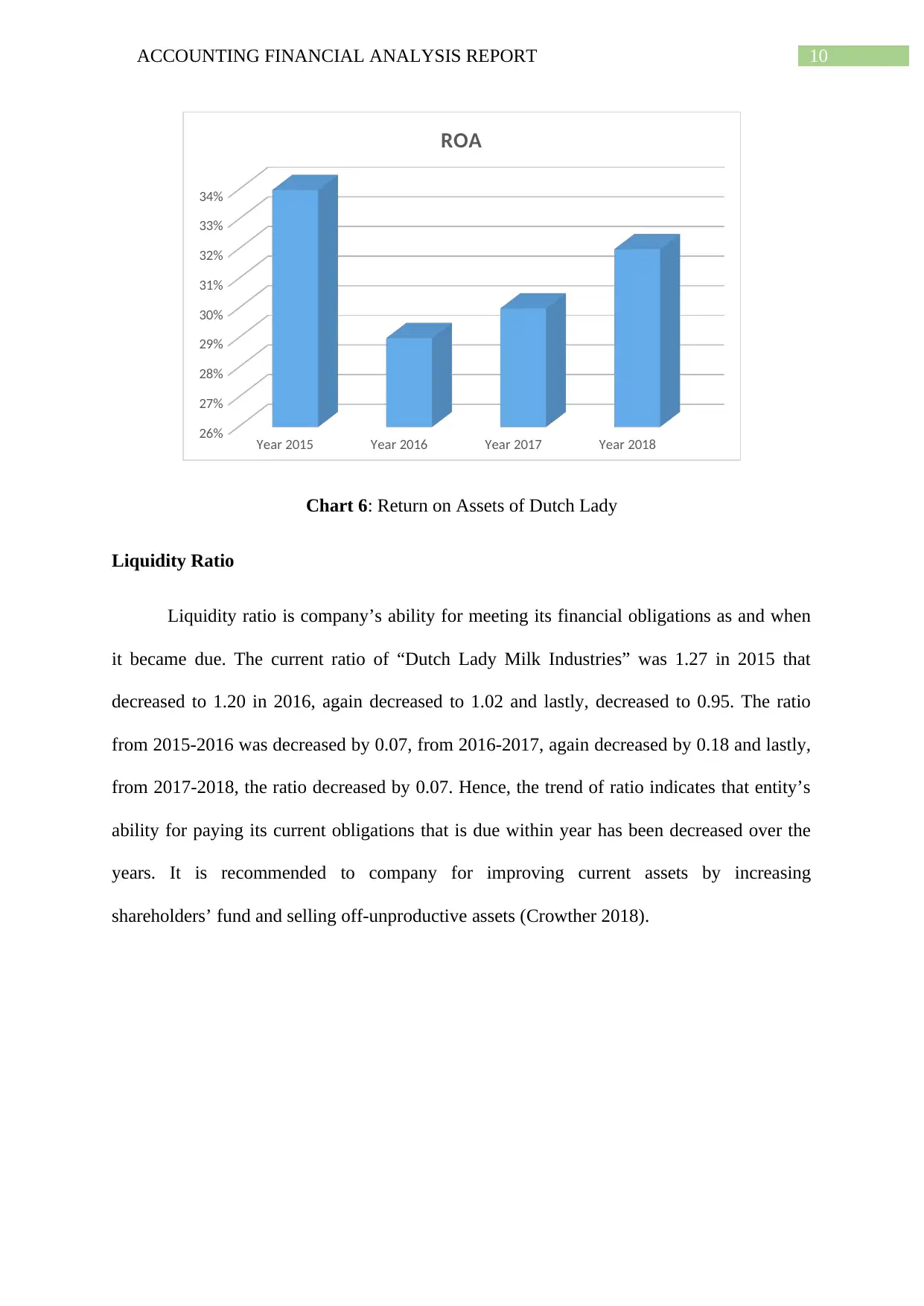
10ACCOUNTING FINANCIAL ANALYSIS REPORT
Year 2015 Year 2016 Year 2017 Year 2018
26%
27%
28%
29%
30%
31%
32%
33%
34%
ROA
Chart 6: Return on Assets of Dutch Lady
Liquidity Ratio
Liquidity ratio is company’s ability for meeting its financial obligations as and when
it became due. The current ratio of “Dutch Lady Milk Industries” was 1.27 in 2015 that
decreased to 1.20 in 2016, again decreased to 1.02 and lastly, decreased to 0.95. The ratio
from 2015-2016 was decreased by 0.07, from 2016-2017, again decreased by 0.18 and lastly,
from 2017-2018, the ratio decreased by 0.07. Hence, the trend of ratio indicates that entity’s
ability for paying its current obligations that is due within year has been decreased over the
years. It is recommended to company for improving current assets by increasing
shareholders’ fund and selling off-unproductive assets (Crowther 2018).
Year 2015 Year 2016 Year 2017 Year 2018
26%
27%
28%
29%
30%
31%
32%
33%
34%
ROA
Chart 6: Return on Assets of Dutch Lady
Liquidity Ratio
Liquidity ratio is company’s ability for meeting its financial obligations as and when
it became due. The current ratio of “Dutch Lady Milk Industries” was 1.27 in 2015 that
decreased to 1.20 in 2016, again decreased to 1.02 and lastly, decreased to 0.95. The ratio
from 2015-2016 was decreased by 0.07, from 2016-2017, again decreased by 0.18 and lastly,
from 2017-2018, the ratio decreased by 0.07. Hence, the trend of ratio indicates that entity’s
ability for paying its current obligations that is due within year has been decreased over the
years. It is recommended to company for improving current assets by increasing
shareholders’ fund and selling off-unproductive assets (Crowther 2018).
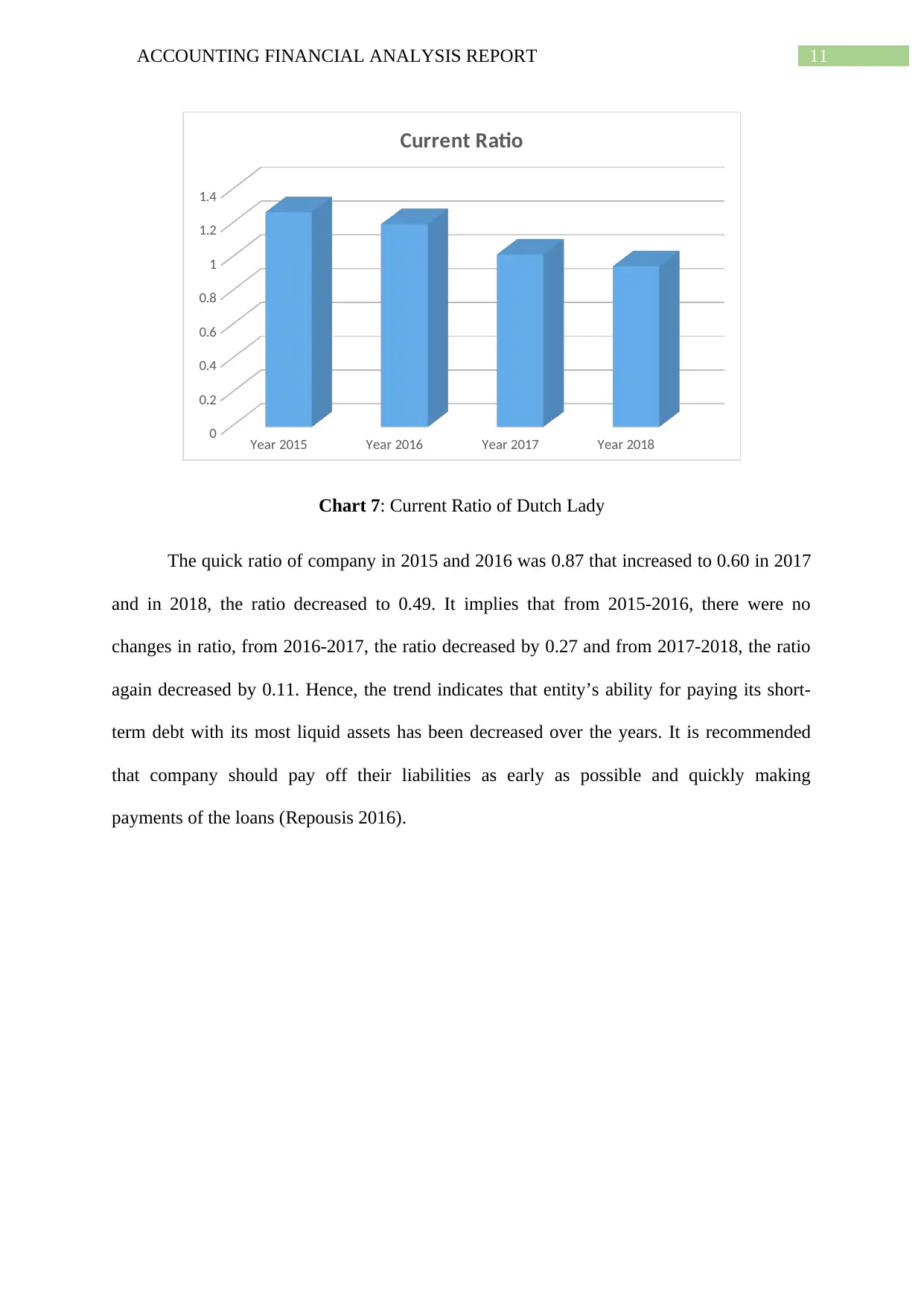
11ACCOUNTING FINANCIAL ANALYSIS REPORT
Year 2015 Year 2016 Year 2017 Year 2018
0
0.2
0.4
0.6
0.8
1
1.2
1.4
Current Ratio
Chart 7: Current Ratio of Dutch Lady
The quick ratio of company in 2015 and 2016 was 0.87 that increased to 0.60 in 2017
and in 2018, the ratio decreased to 0.49. It implies that from 2015-2016, there were no
changes in ratio, from 2016-2017, the ratio decreased by 0.27 and from 2017-2018, the ratio
again decreased by 0.11. Hence, the trend indicates that entity’s ability for paying its short-
term debt with its most liquid assets has been decreased over the years. It is recommended
that company should pay off their liabilities as early as possible and quickly making
payments of the loans (Repousis 2016).
Year 2015 Year 2016 Year 2017 Year 2018
0
0.2
0.4
0.6
0.8
1
1.2
1.4
Current Ratio
Chart 7: Current Ratio of Dutch Lady
The quick ratio of company in 2015 and 2016 was 0.87 that increased to 0.60 in 2017
and in 2018, the ratio decreased to 0.49. It implies that from 2015-2016, there were no
changes in ratio, from 2016-2017, the ratio decreased by 0.27 and from 2017-2018, the ratio
again decreased by 0.11. Hence, the trend indicates that entity’s ability for paying its short-
term debt with its most liquid assets has been decreased over the years. It is recommended
that company should pay off their liabilities as early as possible and quickly making
payments of the loans (Repousis 2016).
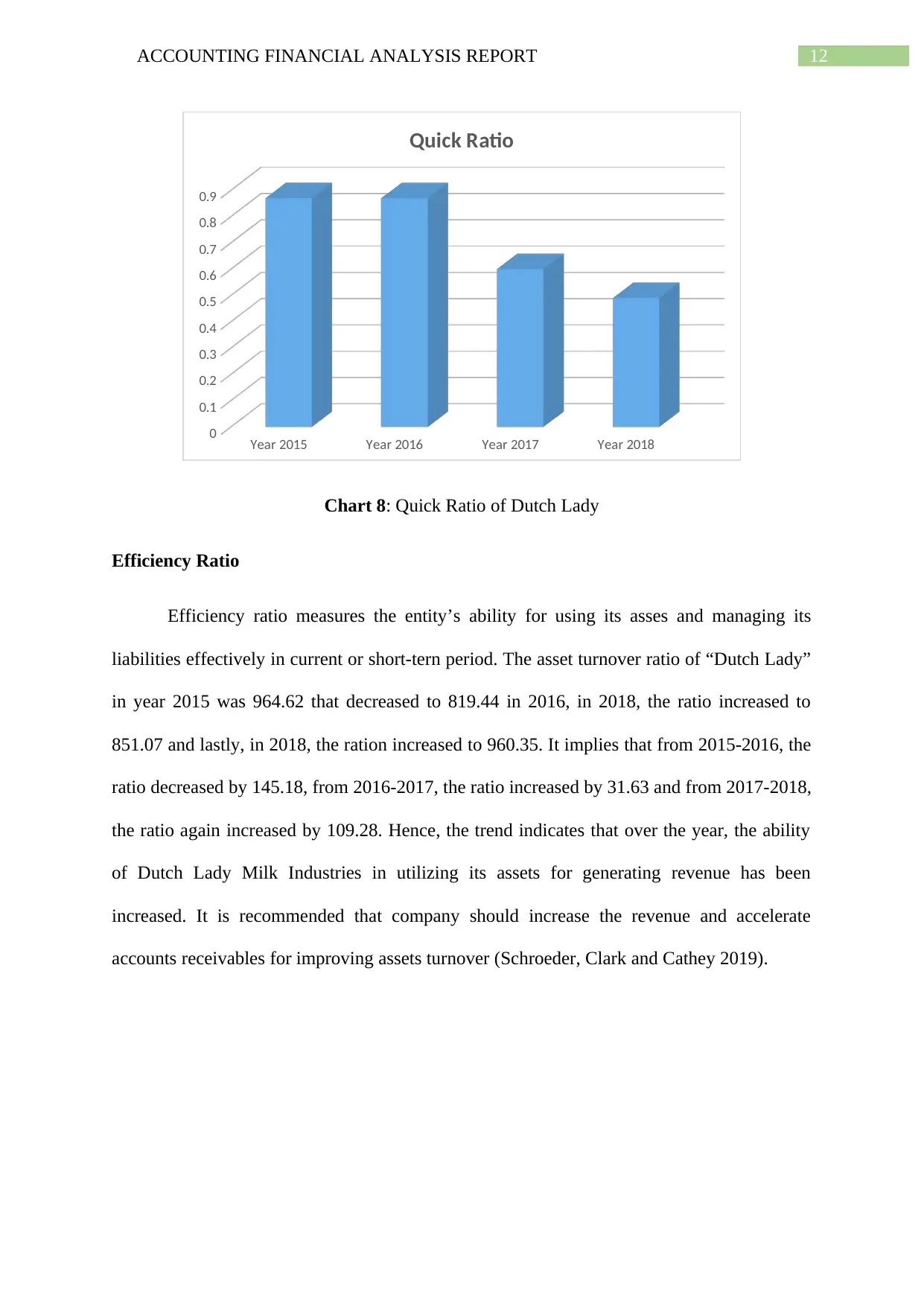
12ACCOUNTING FINANCIAL ANALYSIS REPORT
Year 2015 Year 2016 Year 2017 Year 2018
0
0.1
0.2
0.3
0.4
0.5
0.6
0.7
0.8
0.9
Quick Ratio
Chart 8: Quick Ratio of Dutch Lady
Efficiency Ratio
Efficiency ratio measures the entity’s ability for using its asses and managing its
liabilities effectively in current or short-tern period. The asset turnover ratio of “Dutch Lady”
in year 2015 was 964.62 that decreased to 819.44 in 2016, in 2018, the ratio increased to
851.07 and lastly, in 2018, the ration increased to 960.35. It implies that from 2015-2016, the
ratio decreased by 145.18, from 2016-2017, the ratio increased by 31.63 and from 2017-2018,
the ratio again increased by 109.28. Hence, the trend indicates that over the year, the ability
of Dutch Lady Milk Industries in utilizing its assets for generating revenue has been
increased. It is recommended that company should increase the revenue and accelerate
accounts receivables for improving assets turnover (Schroeder, Clark and Cathey 2019).
Year 2015 Year 2016 Year 2017 Year 2018
0
0.1
0.2
0.3
0.4
0.5
0.6
0.7
0.8
0.9
Quick Ratio
Chart 8: Quick Ratio of Dutch Lady
Efficiency Ratio
Efficiency ratio measures the entity’s ability for using its asses and managing its
liabilities effectively in current or short-tern period. The asset turnover ratio of “Dutch Lady”
in year 2015 was 964.62 that decreased to 819.44 in 2016, in 2018, the ratio increased to
851.07 and lastly, in 2018, the ration increased to 960.35. It implies that from 2015-2016, the
ratio decreased by 145.18, from 2016-2017, the ratio increased by 31.63 and from 2017-2018,
the ratio again increased by 109.28. Hence, the trend indicates that over the year, the ability
of Dutch Lady Milk Industries in utilizing its assets for generating revenue has been
increased. It is recommended that company should increase the revenue and accelerate
accounts receivables for improving assets turnover (Schroeder, Clark and Cathey 2019).
Paraphrase This Document
Need a fresh take? Get an instant paraphrase of this document with our AI Paraphraser
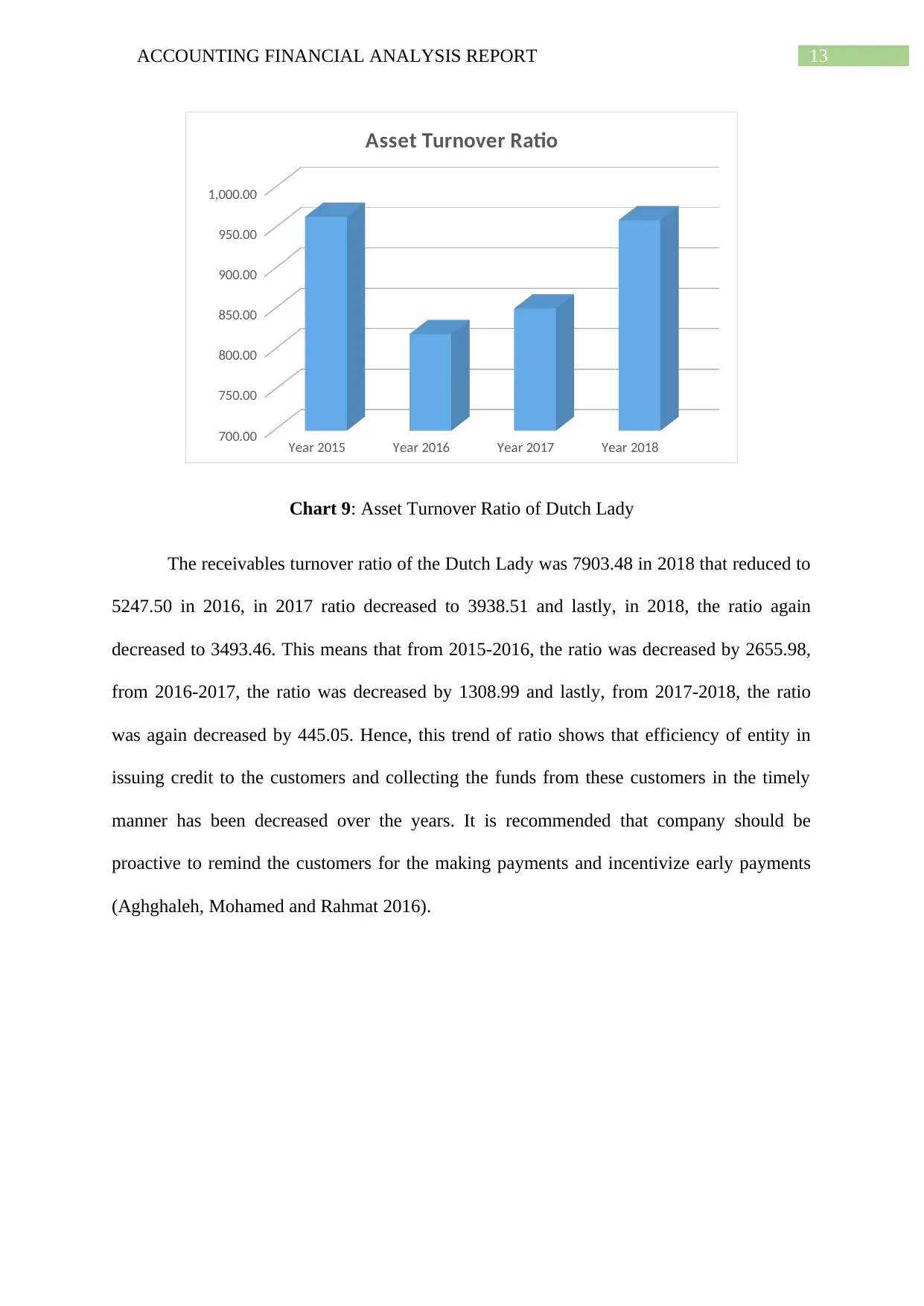
13ACCOUNTING FINANCIAL ANALYSIS REPORT
Year 2015 Year 2016 Year 2017 Year 2018
700.00
750.00
800.00
850.00
900.00
950.00
1,000.00
Asset Turnover Ratio
Chart 9: Asset Turnover Ratio of Dutch Lady
The receivables turnover ratio of the Dutch Lady was 7903.48 in 2018 that reduced to
5247.50 in 2016, in 2017 ratio decreased to 3938.51 and lastly, in 2018, the ratio again
decreased to 3493.46. This means that from 2015-2016, the ratio was decreased by 2655.98,
from 2016-2017, the ratio was decreased by 1308.99 and lastly, from 2017-2018, the ratio
was again decreased by 445.05. Hence, this trend of ratio shows that efficiency of entity in
issuing credit to the customers and collecting the funds from these customers in the timely
manner has been decreased over the years. It is recommended that company should be
proactive to remind the customers for the making payments and incentivize early payments
(Aghghaleh, Mohamed and Rahmat 2016).
Year 2015 Year 2016 Year 2017 Year 2018
700.00
750.00
800.00
850.00
900.00
950.00
1,000.00
Asset Turnover Ratio
Chart 9: Asset Turnover Ratio of Dutch Lady
The receivables turnover ratio of the Dutch Lady was 7903.48 in 2018 that reduced to
5247.50 in 2016, in 2017 ratio decreased to 3938.51 and lastly, in 2018, the ratio again
decreased to 3493.46. This means that from 2015-2016, the ratio was decreased by 2655.98,
from 2016-2017, the ratio was decreased by 1308.99 and lastly, from 2017-2018, the ratio
was again decreased by 445.05. Hence, this trend of ratio shows that efficiency of entity in
issuing credit to the customers and collecting the funds from these customers in the timely
manner has been decreased over the years. It is recommended that company should be
proactive to remind the customers for the making payments and incentivize early payments
(Aghghaleh, Mohamed and Rahmat 2016).
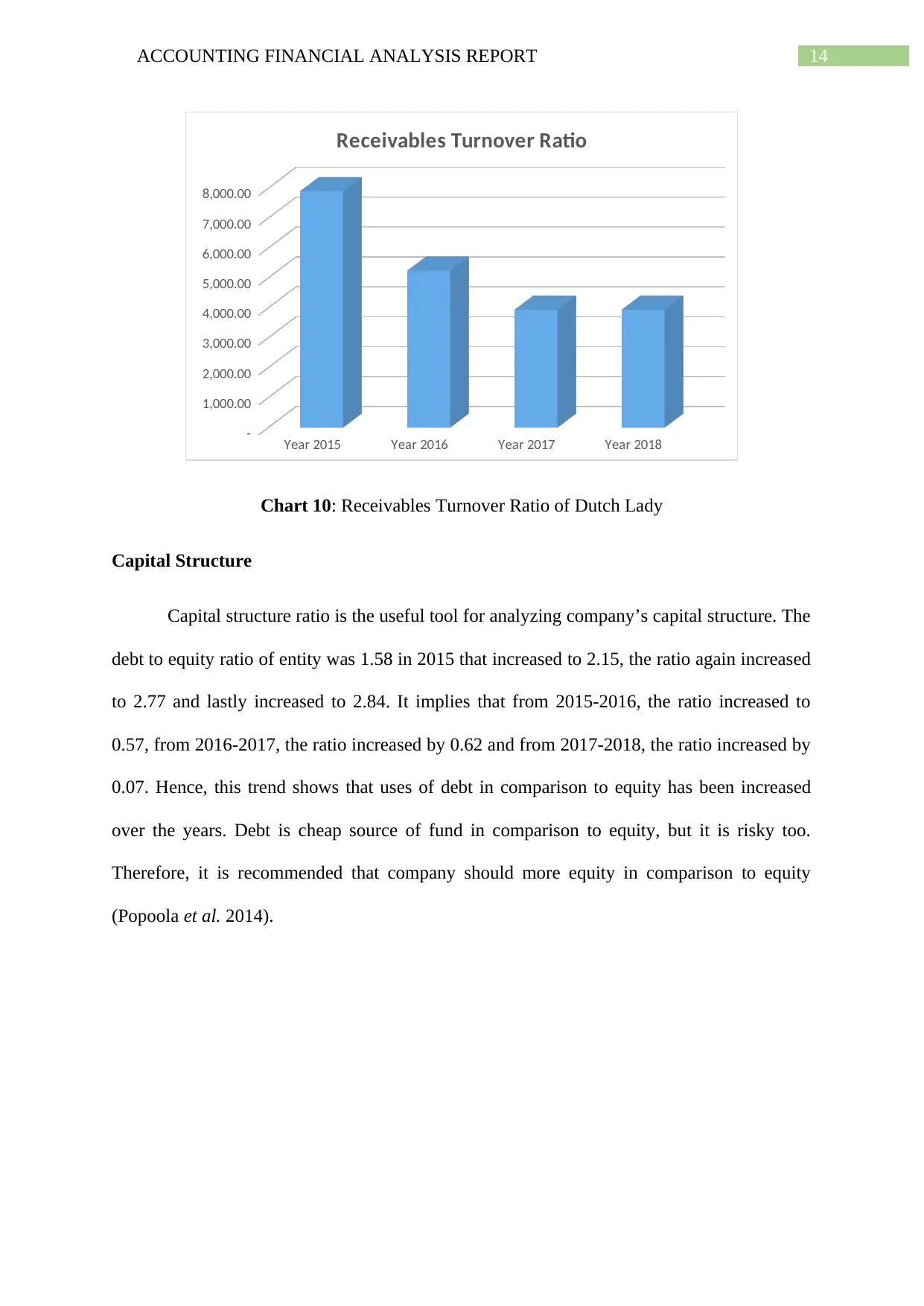
14ACCOUNTING FINANCIAL ANALYSIS REPORT
Year 2015 Year 2016 Year 2017 Year 2018
-
1,000.00
2,000.00
3,000.00
4,000.00
5,000.00
6,000.00
7,000.00
8,000.00
Receivables Turnover Ratio
Chart 10: Receivables Turnover Ratio of Dutch Lady
Capital Structure
Capital structure ratio is the useful tool for analyzing company’s capital structure. The
debt to equity ratio of entity was 1.58 in 2015 that increased to 2.15, the ratio again increased
to 2.77 and lastly increased to 2.84. It implies that from 2015-2016, the ratio increased to
0.57, from 2016-2017, the ratio increased by 0.62 and from 2017-2018, the ratio increased by
0.07. Hence, this trend shows that uses of debt in comparison to equity has been increased
over the years. Debt is cheap source of fund in comparison to equity, but it is risky too.
Therefore, it is recommended that company should more equity in comparison to equity
(Popoola et al. 2014).
Year 2015 Year 2016 Year 2017 Year 2018
-
1,000.00
2,000.00
3,000.00
4,000.00
5,000.00
6,000.00
7,000.00
8,000.00
Receivables Turnover Ratio
Chart 10: Receivables Turnover Ratio of Dutch Lady
Capital Structure
Capital structure ratio is the useful tool for analyzing company’s capital structure. The
debt to equity ratio of entity was 1.58 in 2015 that increased to 2.15, the ratio again increased
to 2.77 and lastly increased to 2.84. It implies that from 2015-2016, the ratio increased to
0.57, from 2016-2017, the ratio increased by 0.62 and from 2017-2018, the ratio increased by
0.07. Hence, this trend shows that uses of debt in comparison to equity has been increased
over the years. Debt is cheap source of fund in comparison to equity, but it is risky too.
Therefore, it is recommended that company should more equity in comparison to equity
(Popoola et al. 2014).
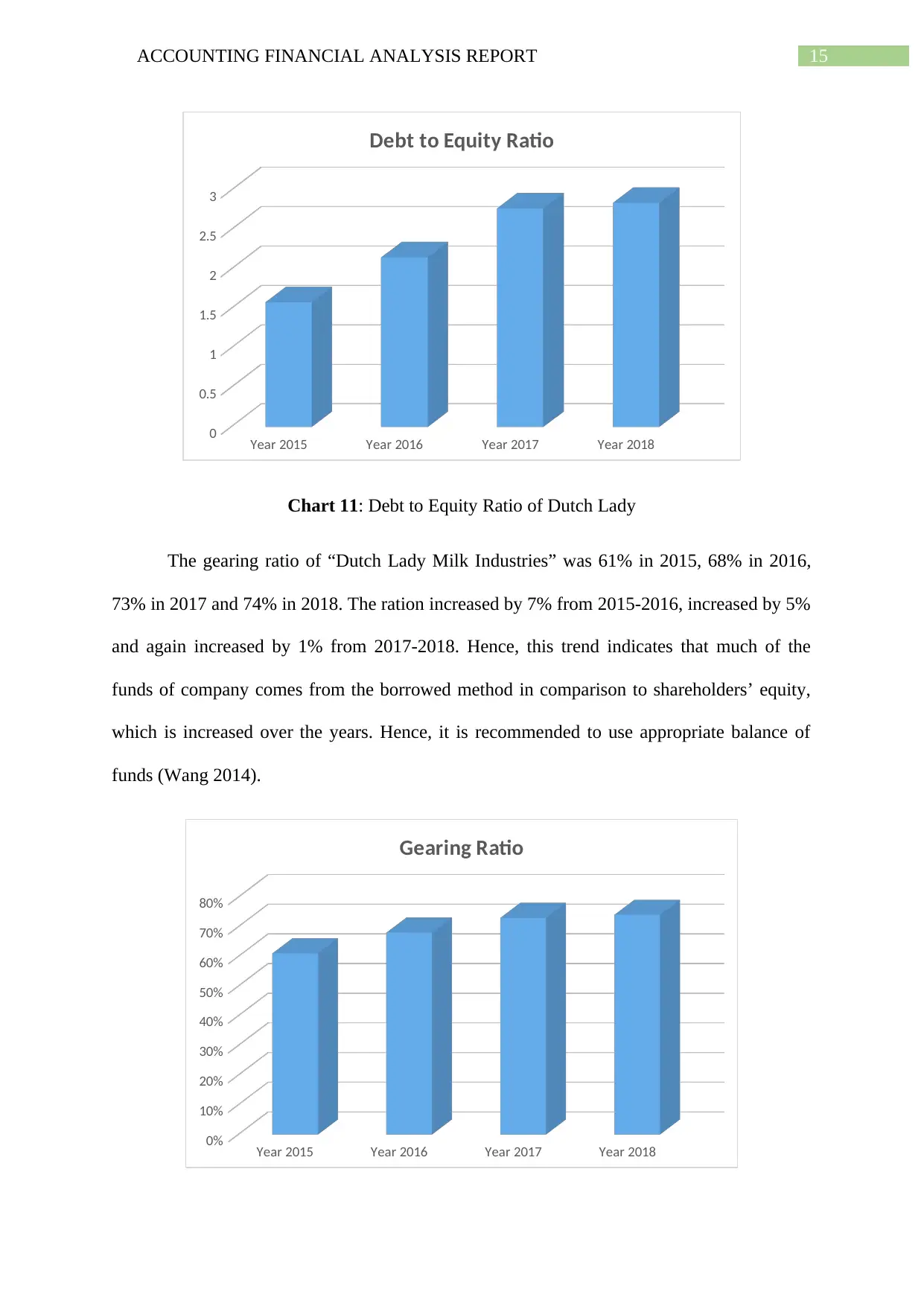
15ACCOUNTING FINANCIAL ANALYSIS REPORT
Year 2015 Year 2016 Year 2017 Year 2018
0
0.5
1
1.5
2
2.5
3
Debt to Equity Ratio
Chart 11: Debt to Equity Ratio of Dutch Lady
The gearing ratio of “Dutch Lady Milk Industries” was 61% in 2015, 68% in 2016,
73% in 2017 and 74% in 2018. The ration increased by 7% from 2015-2016, increased by 5%
and again increased by 1% from 2017-2018. Hence, this trend indicates that much of the
funds of company comes from the borrowed method in comparison to shareholders’ equity,
which is increased over the years. Hence, it is recommended to use appropriate balance of
funds (Wang 2014).
Year 2015 Year 2016 Year 2017 Year 2018
0%
10%
20%
30%
40%
50%
60%
70%
80%
Gearing Ratio
Year 2015 Year 2016 Year 2017 Year 2018
0
0.5
1
1.5
2
2.5
3
Debt to Equity Ratio
Chart 11: Debt to Equity Ratio of Dutch Lady
The gearing ratio of “Dutch Lady Milk Industries” was 61% in 2015, 68% in 2016,
73% in 2017 and 74% in 2018. The ration increased by 7% from 2015-2016, increased by 5%
and again increased by 1% from 2017-2018. Hence, this trend indicates that much of the
funds of company comes from the borrowed method in comparison to shareholders’ equity,
which is increased over the years. Hence, it is recommended to use appropriate balance of
funds (Wang 2014).
Year 2015 Year 2016 Year 2017 Year 2018
0%
10%
20%
30%
40%
50%
60%
70%
80%
Gearing Ratio
Secure Best Marks with AI Grader
Need help grading? Try our AI Grader for instant feedback on your assignments.
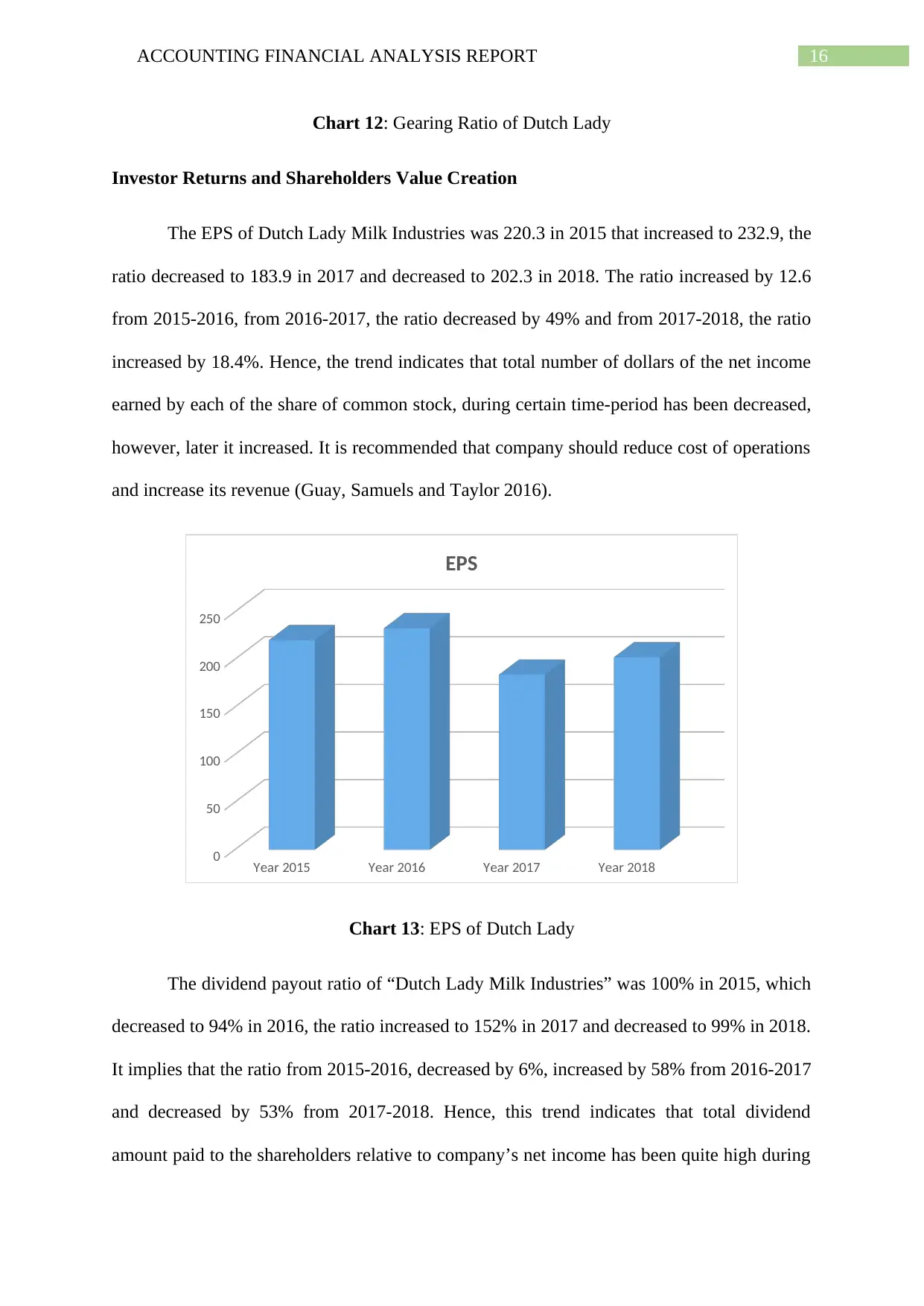
16ACCOUNTING FINANCIAL ANALYSIS REPORT
Chart 12: Gearing Ratio of Dutch Lady
Investor Returns and Shareholders Value Creation
The EPS of Dutch Lady Milk Industries was 220.3 in 2015 that increased to 232.9, the
ratio decreased to 183.9 in 2017 and decreased to 202.3 in 2018. The ratio increased by 12.6
from 2015-2016, from 2016-2017, the ratio decreased by 49% and from 2017-2018, the ratio
increased by 18.4%. Hence, the trend indicates that total number of dollars of the net income
earned by each of the share of common stock, during certain time-period has been decreased,
however, later it increased. It is recommended that company should reduce cost of operations
and increase its revenue (Guay, Samuels and Taylor 2016).
Year 2015 Year 2016 Year 2017 Year 2018
0
50
100
150
200
250
EPS
Chart 13: EPS of Dutch Lady
The dividend payout ratio of “Dutch Lady Milk Industries” was 100% in 2015, which
decreased to 94% in 2016, the ratio increased to 152% in 2017 and decreased to 99% in 2018.
It implies that the ratio from 2015-2016, decreased by 6%, increased by 58% from 2016-2017
and decreased by 53% from 2017-2018. Hence, this trend indicates that total dividend
amount paid to the shareholders relative to company’s net income has been quite high during
Chart 12: Gearing Ratio of Dutch Lady
Investor Returns and Shareholders Value Creation
The EPS of Dutch Lady Milk Industries was 220.3 in 2015 that increased to 232.9, the
ratio decreased to 183.9 in 2017 and decreased to 202.3 in 2018. The ratio increased by 12.6
from 2015-2016, from 2016-2017, the ratio decreased by 49% and from 2017-2018, the ratio
increased by 18.4%. Hence, the trend indicates that total number of dollars of the net income
earned by each of the share of common stock, during certain time-period has been decreased,
however, later it increased. It is recommended that company should reduce cost of operations
and increase its revenue (Guay, Samuels and Taylor 2016).
Year 2015 Year 2016 Year 2017 Year 2018
0
50
100
150
200
250
EPS
Chart 13: EPS of Dutch Lady
The dividend payout ratio of “Dutch Lady Milk Industries” was 100% in 2015, which
decreased to 94% in 2016, the ratio increased to 152% in 2017 and decreased to 99% in 2018.
It implies that the ratio from 2015-2016, decreased by 6%, increased by 58% from 2016-2017
and decreased by 53% from 2017-2018. Hence, this trend indicates that total dividend
amount paid to the shareholders relative to company’s net income has been quite high during
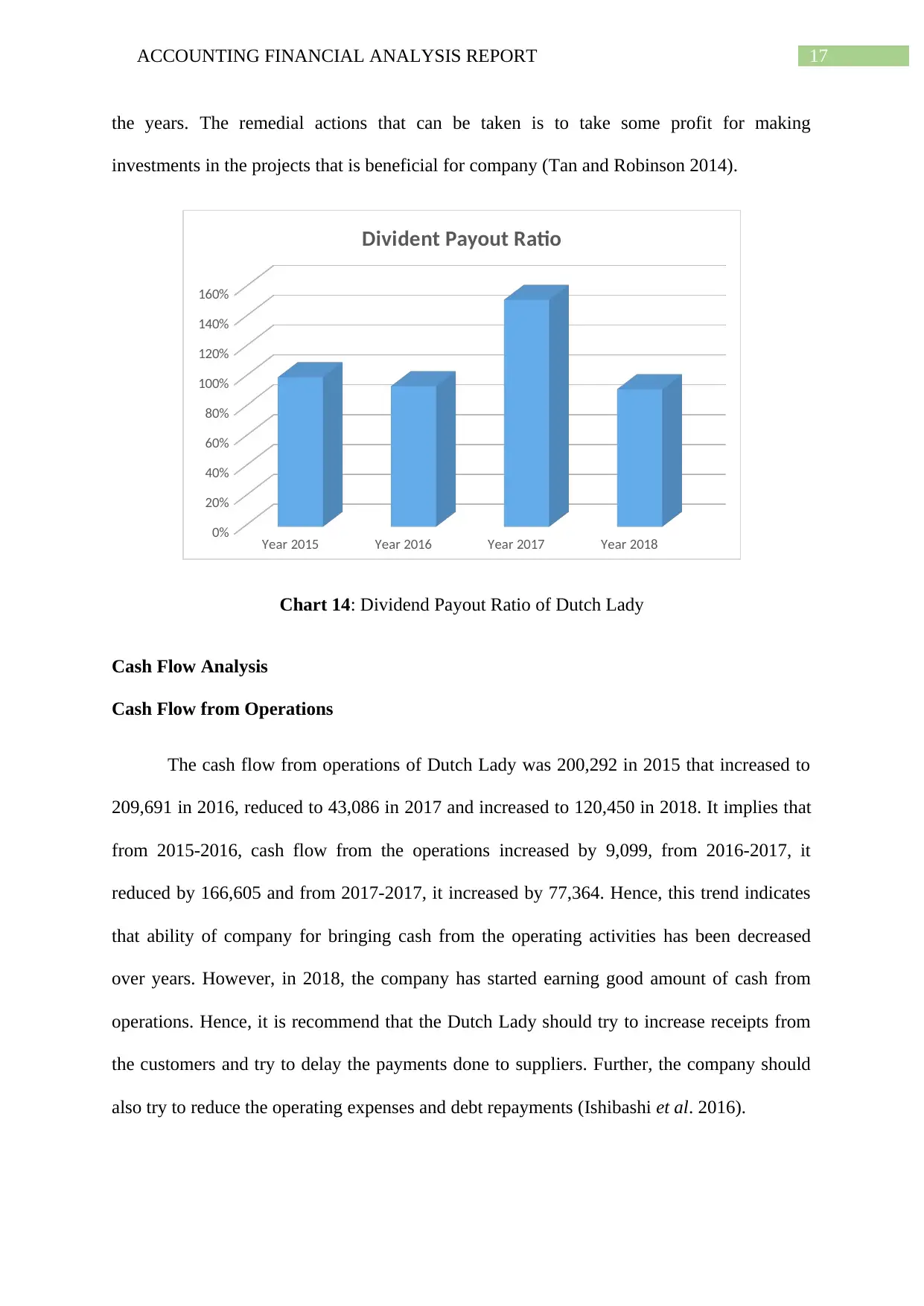
17ACCOUNTING FINANCIAL ANALYSIS REPORT
the years. The remedial actions that can be taken is to take some profit for making
investments in the projects that is beneficial for company (Tan and Robinson 2014).
Year 2015 Year 2016 Year 2017 Year 2018
0%
20%
40%
60%
80%
100%
120%
140%
160%
Divident Payout Ratio
Chart 14: Dividend Payout Ratio of Dutch Lady
Cash Flow Analysis
Cash Flow from Operations
The cash flow from operations of Dutch Lady was 200,292 in 2015 that increased to
209,691 in 2016, reduced to 43,086 in 2017 and increased to 120,450 in 2018. It implies that
from 2015-2016, cash flow from the operations increased by 9,099, from 2016-2017, it
reduced by 166,605 and from 2017-2017, it increased by 77,364. Hence, this trend indicates
that ability of company for bringing cash from the operating activities has been decreased
over years. However, in 2018, the company has started earning good amount of cash from
operations. Hence, it is recommend that the Dutch Lady should try to increase receipts from
the customers and try to delay the payments done to suppliers. Further, the company should
also try to reduce the operating expenses and debt repayments (Ishibashi et al. 2016).
the years. The remedial actions that can be taken is to take some profit for making
investments in the projects that is beneficial for company (Tan and Robinson 2014).
Year 2015 Year 2016 Year 2017 Year 2018
0%
20%
40%
60%
80%
100%
120%
140%
160%
Divident Payout Ratio
Chart 14: Dividend Payout Ratio of Dutch Lady
Cash Flow Analysis
Cash Flow from Operations
The cash flow from operations of Dutch Lady was 200,292 in 2015 that increased to
209,691 in 2016, reduced to 43,086 in 2017 and increased to 120,450 in 2018. It implies that
from 2015-2016, cash flow from the operations increased by 9,099, from 2016-2017, it
reduced by 166,605 and from 2017-2017, it increased by 77,364. Hence, this trend indicates
that ability of company for bringing cash from the operating activities has been decreased
over years. However, in 2018, the company has started earning good amount of cash from
operations. Hence, it is recommend that the Dutch Lady should try to increase receipts from
the customers and try to delay the payments done to suppliers. Further, the company should
also try to reduce the operating expenses and debt repayments (Ishibashi et al. 2016).
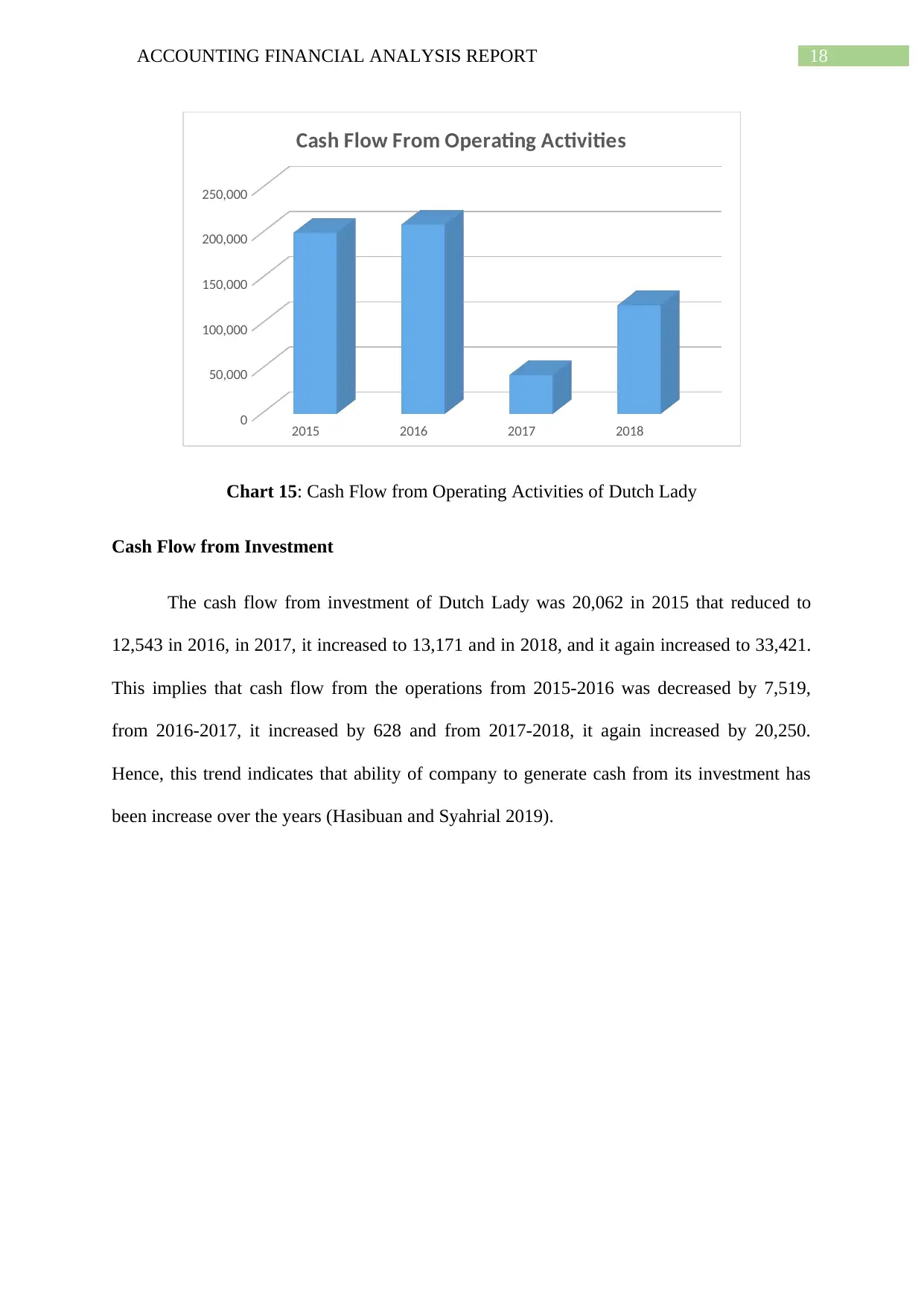
18ACCOUNTING FINANCIAL ANALYSIS REPORT
2015 2016 2017 2018
0
50,000
100,000
150,000
200,000
250,000
Cash Flow From Operating Activities
Chart 15: Cash Flow from Operating Activities of Dutch Lady
Cash Flow from Investment
The cash flow from investment of Dutch Lady was 20,062 in 2015 that reduced to
12,543 in 2016, in 2017, it increased to 13,171 and in 2018, and it again increased to 33,421.
This implies that cash flow from the operations from 2015-2016 was decreased by 7,519,
from 2016-2017, it increased by 628 and from 2017-2018, it again increased by 20,250.
Hence, this trend indicates that ability of company to generate cash from its investment has
been increase over the years (Hasibuan and Syahrial 2019).
2015 2016 2017 2018
0
50,000
100,000
150,000
200,000
250,000
Cash Flow From Operating Activities
Chart 15: Cash Flow from Operating Activities of Dutch Lady
Cash Flow from Investment
The cash flow from investment of Dutch Lady was 20,062 in 2015 that reduced to
12,543 in 2016, in 2017, it increased to 13,171 and in 2018, and it again increased to 33,421.
This implies that cash flow from the operations from 2015-2016 was decreased by 7,519,
from 2016-2017, it increased by 628 and from 2017-2018, it again increased by 20,250.
Hence, this trend indicates that ability of company to generate cash from its investment has
been increase over the years (Hasibuan and Syahrial 2019).
Paraphrase This Document
Need a fresh take? Get an instant paraphrase of this document with our AI Paraphraser
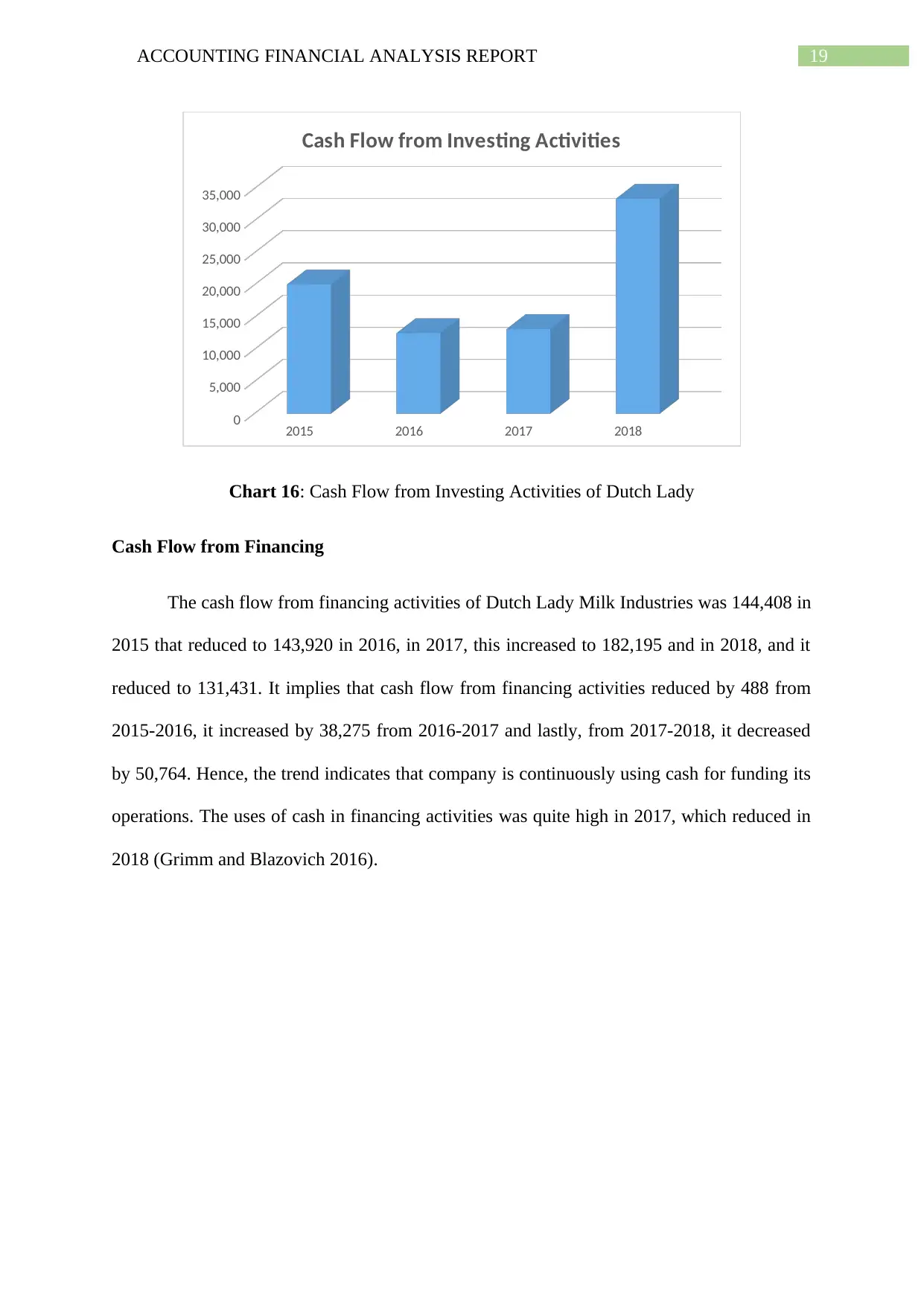
19ACCOUNTING FINANCIAL ANALYSIS REPORT
2015 2016 2017 2018
0
5,000
10,000
15,000
20,000
25,000
30,000
35,000
Cash Flow from Investing Activities
Chart 16: Cash Flow from Investing Activities of Dutch Lady
Cash Flow from Financing
The cash flow from financing activities of Dutch Lady Milk Industries was 144,408 in
2015 that reduced to 143,920 in 2016, in 2017, this increased to 182,195 and in 2018, and it
reduced to 131,431. It implies that cash flow from financing activities reduced by 488 from
2015-2016, it increased by 38,275 from 2016-2017 and lastly, from 2017-2018, it decreased
by 50,764. Hence, the trend indicates that company is continuously using cash for funding its
operations. The uses of cash in financing activities was quite high in 2017, which reduced in
2018 (Grimm and Blazovich 2016).
2015 2016 2017 2018
0
5,000
10,000
15,000
20,000
25,000
30,000
35,000
Cash Flow from Investing Activities
Chart 16: Cash Flow from Investing Activities of Dutch Lady
Cash Flow from Financing
The cash flow from financing activities of Dutch Lady Milk Industries was 144,408 in
2015 that reduced to 143,920 in 2016, in 2017, this increased to 182,195 and in 2018, and it
reduced to 131,431. It implies that cash flow from financing activities reduced by 488 from
2015-2016, it increased by 38,275 from 2016-2017 and lastly, from 2017-2018, it decreased
by 50,764. Hence, the trend indicates that company is continuously using cash for funding its
operations. The uses of cash in financing activities was quite high in 2017, which reduced in
2018 (Grimm and Blazovich 2016).
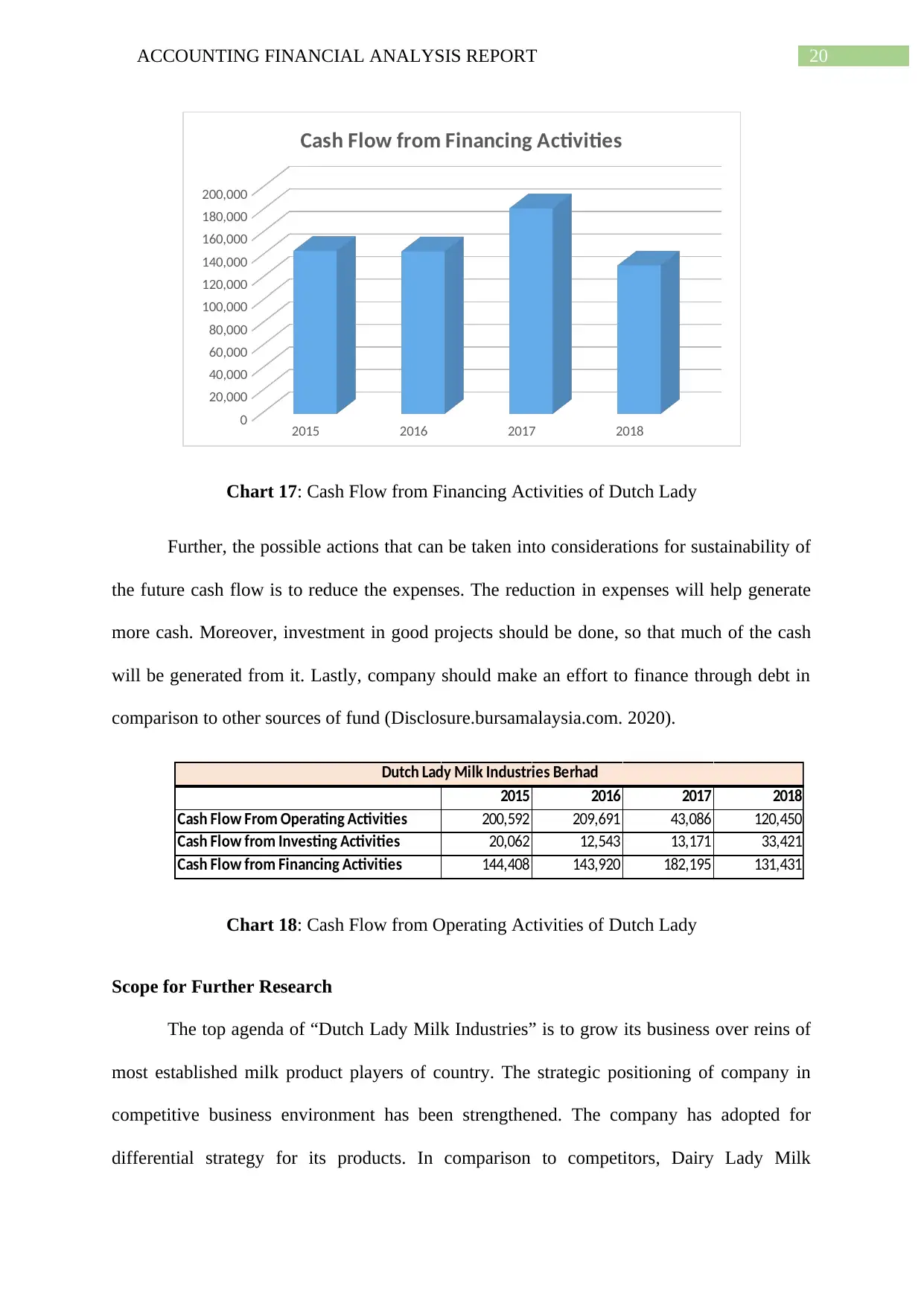
20ACCOUNTING FINANCIAL ANALYSIS REPORT
2015 2016 2017 2018
0
20,000
40,000
60,000
80,000
100,000
120,000
140,000
160,000
180,000
200,000
Cash Flow from Financing Activities
Chart 17: Cash Flow from Financing Activities of Dutch Lady
Further, the possible actions that can be taken into considerations for sustainability of
the future cash flow is to reduce the expenses. The reduction in expenses will help generate
more cash. Moreover, investment in good projects should be done, so that much of the cash
will be generated from it. Lastly, company should make an effort to finance through debt in
comparison to other sources of fund (Disclosure.bursamalaysia.com. 2020).
2015 2016 2017 2018
Cash Flow From Operating Activities 200,592 209,691 43,086 120,450
Cash Flow from Investing Activities 20,062 12,543 13,171 33,421
Cash Flow from Financing Activities 144,408 143,920 182,195 131,431
Dutch Lady Milk Industries Berhad
Chart 18: Cash Flow from Operating Activities of Dutch Lady
Scope for Further Research
The top agenda of “Dutch Lady Milk Industries” is to grow its business over reins of
most established milk product players of country. The strategic positioning of company in
competitive business environment has been strengthened. The company has adopted for
differential strategy for its products. In comparison to competitors, Dairy Lady Milk
2015 2016 2017 2018
0
20,000
40,000
60,000
80,000
100,000
120,000
140,000
160,000
180,000
200,000
Cash Flow from Financing Activities
Chart 17: Cash Flow from Financing Activities of Dutch Lady
Further, the possible actions that can be taken into considerations for sustainability of
the future cash flow is to reduce the expenses. The reduction in expenses will help generate
more cash. Moreover, investment in good projects should be done, so that much of the cash
will be generated from it. Lastly, company should make an effort to finance through debt in
comparison to other sources of fund (Disclosure.bursamalaysia.com. 2020).
2015 2016 2017 2018
Cash Flow From Operating Activities 200,592 209,691 43,086 120,450
Cash Flow from Investing Activities 20,062 12,543 13,171 33,421
Cash Flow from Financing Activities 144,408 143,920 182,195 131,431
Dutch Lady Milk Industries Berhad
Chart 18: Cash Flow from Operating Activities of Dutch Lady
Scope for Further Research
The top agenda of “Dutch Lady Milk Industries” is to grow its business over reins of
most established milk product players of country. The strategic positioning of company in
competitive business environment has been strengthened. The company has adopted for
differential strategy for its products. In comparison to competitors, Dairy Lady Milk
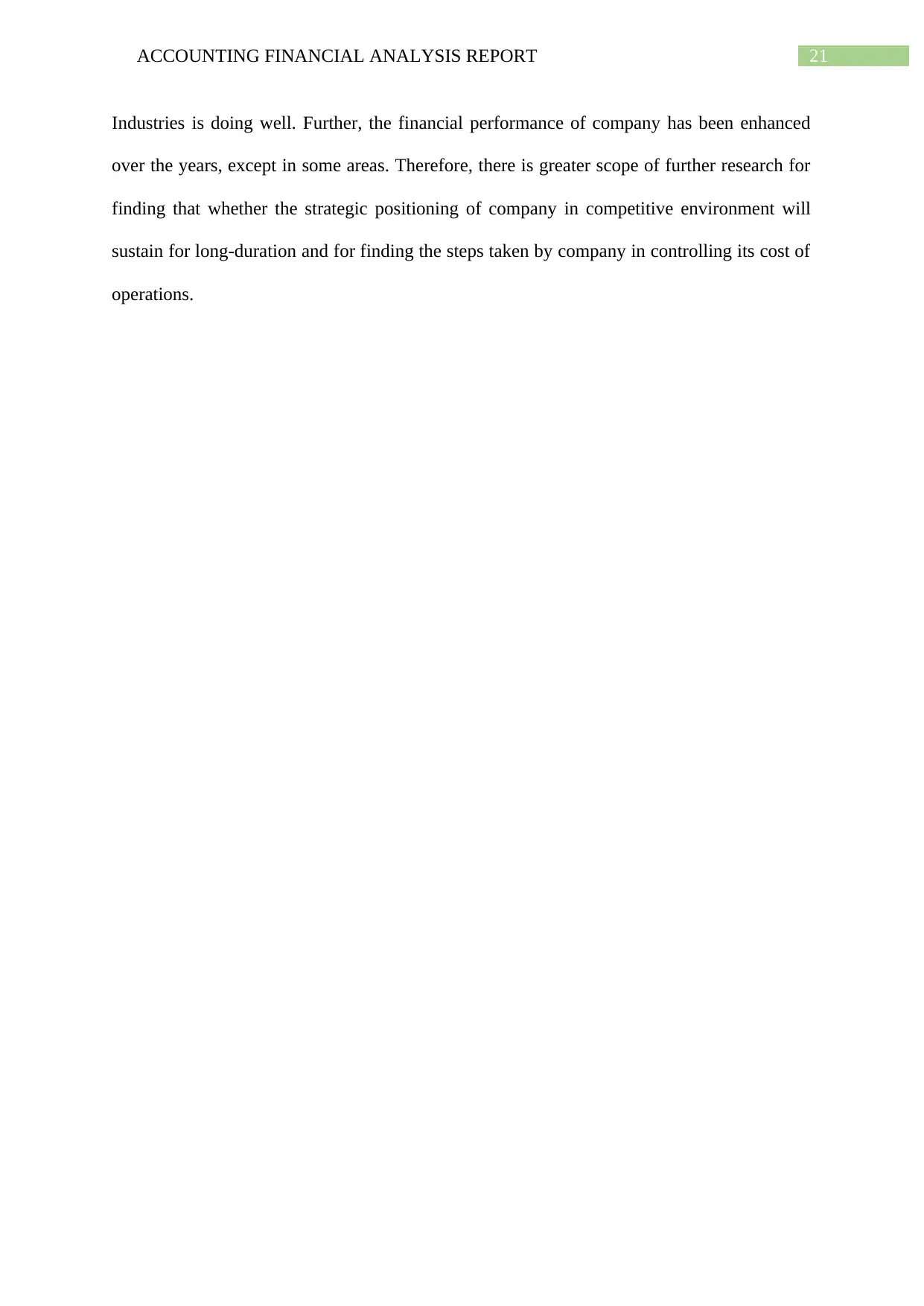
21ACCOUNTING FINANCIAL ANALYSIS REPORT
Industries is doing well. Further, the financial performance of company has been enhanced
over the years, except in some areas. Therefore, there is greater scope of further research for
finding that whether the strategic positioning of company in competitive environment will
sustain for long-duration and for finding the steps taken by company in controlling its cost of
operations.
Industries is doing well. Further, the financial performance of company has been enhanced
over the years, except in some areas. Therefore, there is greater scope of further research for
finding that whether the strategic positioning of company in competitive environment will
sustain for long-duration and for finding the steps taken by company in controlling its cost of
operations.
Secure Best Marks with AI Grader
Need help grading? Try our AI Grader for instant feedback on your assignments.
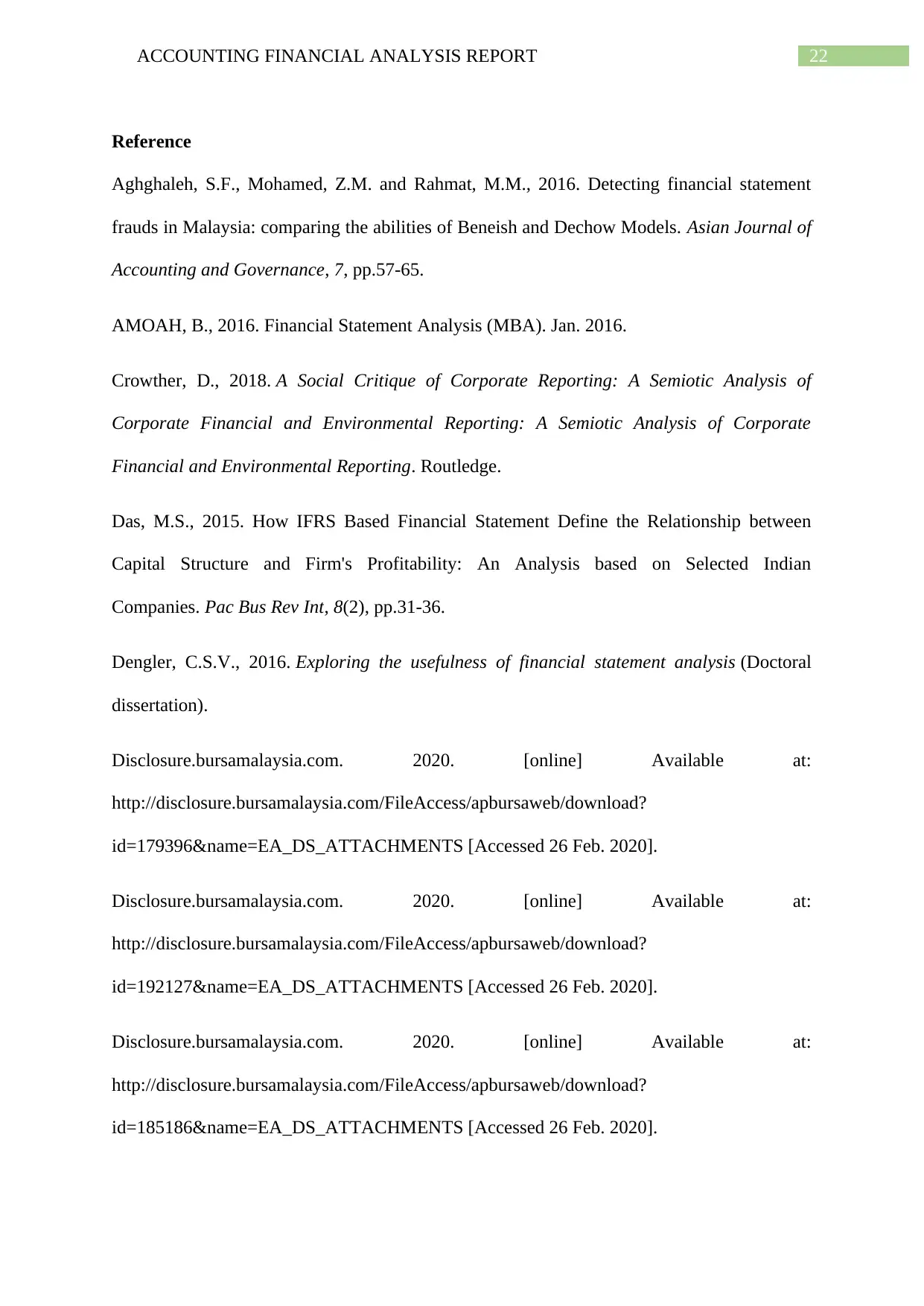
22ACCOUNTING FINANCIAL ANALYSIS REPORT
Reference
Aghghaleh, S.F., Mohamed, Z.M. and Rahmat, M.M., 2016. Detecting financial statement
frauds in Malaysia: comparing the abilities of Beneish and Dechow Models. Asian Journal of
Accounting and Governance, 7, pp.57-65.
AMOAH, B., 2016. Financial Statement Analysis (MBA). Jan. 2016.
Crowther, D., 2018. A Social Critique of Corporate Reporting: A Semiotic Analysis of
Corporate Financial and Environmental Reporting: A Semiotic Analysis of Corporate
Financial and Environmental Reporting. Routledge.
Das, M.S., 2015. How IFRS Based Financial Statement Define the Relationship between
Capital Structure and Firm's Profitability: An Analysis based on Selected Indian
Companies. Pac Bus Rev Int, 8(2), pp.31-36.
Dengler, C.S.V., 2016. Exploring the usefulness of financial statement analysis (Doctoral
dissertation).
Disclosure.bursamalaysia.com. 2020. [online] Available at:
http://disclosure.bursamalaysia.com/FileAccess/apbursaweb/download?
id=179396&name=EA_DS_ATTACHMENTS [Accessed 26 Feb. 2020].
Disclosure.bursamalaysia.com. 2020. [online] Available at:
http://disclosure.bursamalaysia.com/FileAccess/apbursaweb/download?
id=192127&name=EA_DS_ATTACHMENTS [Accessed 26 Feb. 2020].
Disclosure.bursamalaysia.com. 2020. [online] Available at:
http://disclosure.bursamalaysia.com/FileAccess/apbursaweb/download?
id=185186&name=EA_DS_ATTACHMENTS [Accessed 26 Feb. 2020].
Reference
Aghghaleh, S.F., Mohamed, Z.M. and Rahmat, M.M., 2016. Detecting financial statement
frauds in Malaysia: comparing the abilities of Beneish and Dechow Models. Asian Journal of
Accounting and Governance, 7, pp.57-65.
AMOAH, B., 2016. Financial Statement Analysis (MBA). Jan. 2016.
Crowther, D., 2018. A Social Critique of Corporate Reporting: A Semiotic Analysis of
Corporate Financial and Environmental Reporting: A Semiotic Analysis of Corporate
Financial and Environmental Reporting. Routledge.
Das, M.S., 2015. How IFRS Based Financial Statement Define the Relationship between
Capital Structure and Firm's Profitability: An Analysis based on Selected Indian
Companies. Pac Bus Rev Int, 8(2), pp.31-36.
Dengler, C.S.V., 2016. Exploring the usefulness of financial statement analysis (Doctoral
dissertation).
Disclosure.bursamalaysia.com. 2020. [online] Available at:
http://disclosure.bursamalaysia.com/FileAccess/apbursaweb/download?
id=179396&name=EA_DS_ATTACHMENTS [Accessed 26 Feb. 2020].
Disclosure.bursamalaysia.com. 2020. [online] Available at:
http://disclosure.bursamalaysia.com/FileAccess/apbursaweb/download?
id=192127&name=EA_DS_ATTACHMENTS [Accessed 26 Feb. 2020].
Disclosure.bursamalaysia.com. 2020. [online] Available at:
http://disclosure.bursamalaysia.com/FileAccess/apbursaweb/download?
id=185186&name=EA_DS_ATTACHMENTS [Accessed 26 Feb. 2020].
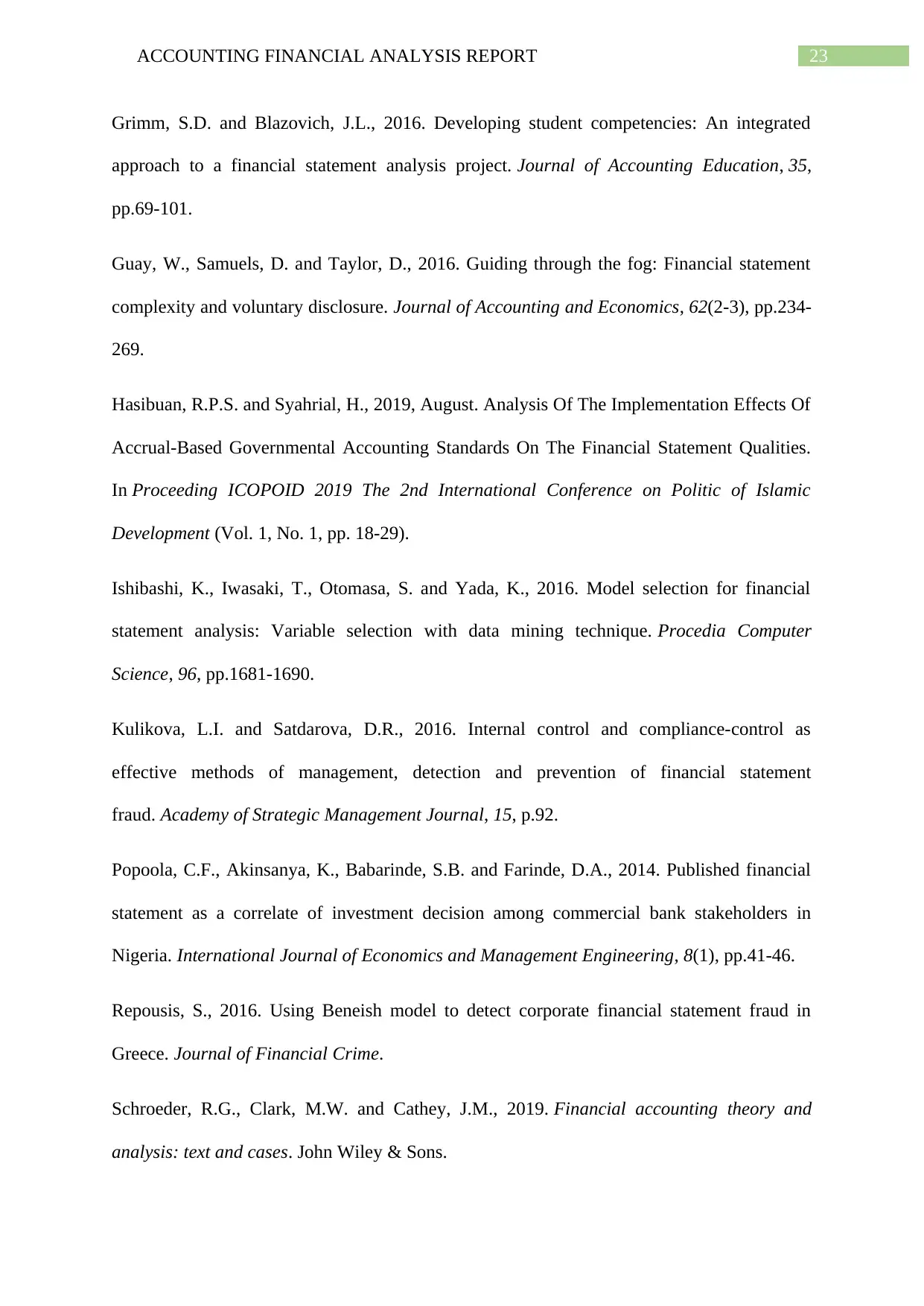
23ACCOUNTING FINANCIAL ANALYSIS REPORT
Grimm, S.D. and Blazovich, J.L., 2016. Developing student competencies: An integrated
approach to a financial statement analysis project. Journal of Accounting Education, 35,
pp.69-101.
Guay, W., Samuels, D. and Taylor, D., 2016. Guiding through the fog: Financial statement
complexity and voluntary disclosure. Journal of Accounting and Economics, 62(2-3), pp.234-
269.
Hasibuan, R.P.S. and Syahrial, H., 2019, August. Analysis Of The Implementation Effects Of
Accrual-Based Governmental Accounting Standards On The Financial Statement Qualities.
In Proceeding ICOPOID 2019 The 2nd International Conference on Politic of Islamic
Development (Vol. 1, No. 1, pp. 18-29).
Ishibashi, K., Iwasaki, T., Otomasa, S. and Yada, K., 2016. Model selection for financial
statement analysis: Variable selection with data mining technique. Procedia Computer
Science, 96, pp.1681-1690.
Kulikova, L.I. and Satdarova, D.R., 2016. Internal control and compliance-control as
effective methods of management, detection and prevention of financial statement
fraud. Academy of Strategic Management Journal, 15, p.92.
Popoola, C.F., Akinsanya, K., Babarinde, S.B. and Farinde, D.A., 2014. Published financial
statement as a correlate of investment decision among commercial bank stakeholders in
Nigeria. International Journal of Economics and Management Engineering, 8(1), pp.41-46.
Repousis, S., 2016. Using Beneish model to detect corporate financial statement fraud in
Greece. Journal of Financial Crime.
Schroeder, R.G., Clark, M.W. and Cathey, J.M., 2019. Financial accounting theory and
analysis: text and cases. John Wiley & Sons.
Grimm, S.D. and Blazovich, J.L., 2016. Developing student competencies: An integrated
approach to a financial statement analysis project. Journal of Accounting Education, 35,
pp.69-101.
Guay, W., Samuels, D. and Taylor, D., 2016. Guiding through the fog: Financial statement
complexity and voluntary disclosure. Journal of Accounting and Economics, 62(2-3), pp.234-
269.
Hasibuan, R.P.S. and Syahrial, H., 2019, August. Analysis Of The Implementation Effects Of
Accrual-Based Governmental Accounting Standards On The Financial Statement Qualities.
In Proceeding ICOPOID 2019 The 2nd International Conference on Politic of Islamic
Development (Vol. 1, No. 1, pp. 18-29).
Ishibashi, K., Iwasaki, T., Otomasa, S. and Yada, K., 2016. Model selection for financial
statement analysis: Variable selection with data mining technique. Procedia Computer
Science, 96, pp.1681-1690.
Kulikova, L.I. and Satdarova, D.R., 2016. Internal control and compliance-control as
effective methods of management, detection and prevention of financial statement
fraud. Academy of Strategic Management Journal, 15, p.92.
Popoola, C.F., Akinsanya, K., Babarinde, S.B. and Farinde, D.A., 2014. Published financial
statement as a correlate of investment decision among commercial bank stakeholders in
Nigeria. International Journal of Economics and Management Engineering, 8(1), pp.41-46.
Repousis, S., 2016. Using Beneish model to detect corporate financial statement fraud in
Greece. Journal of Financial Crime.
Schroeder, R.G., Clark, M.W. and Cathey, J.M., 2019. Financial accounting theory and
analysis: text and cases. John Wiley & Sons.
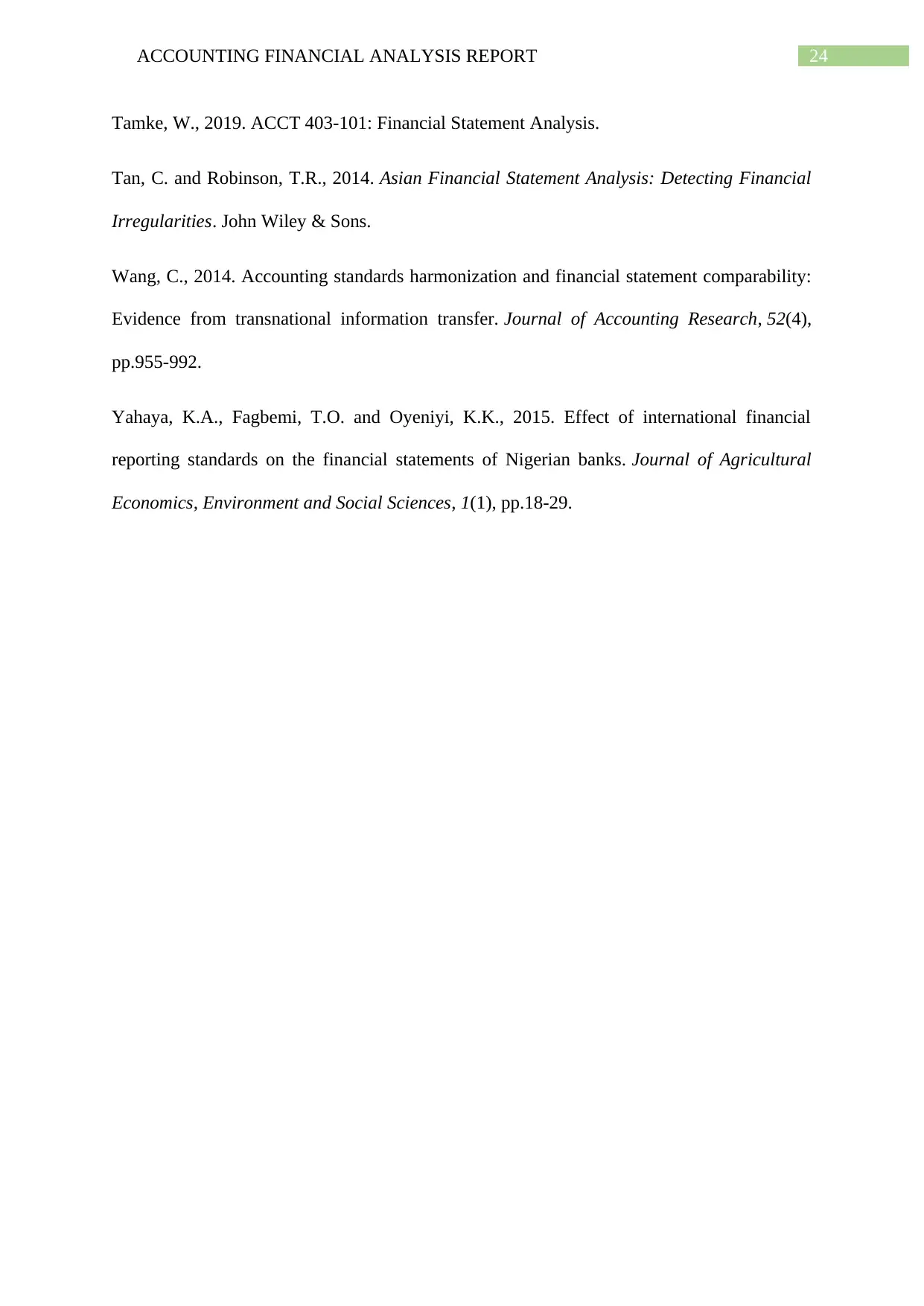
24ACCOUNTING FINANCIAL ANALYSIS REPORT
Tamke, W., 2019. ACCT 403-101: Financial Statement Analysis.
Tan, C. and Robinson, T.R., 2014. Asian Financial Statement Analysis: Detecting Financial
Irregularities. John Wiley & Sons.
Wang, C., 2014. Accounting standards harmonization and financial statement comparability:
Evidence from transnational information transfer. Journal of Accounting Research, 52(4),
pp.955-992.
Yahaya, K.A., Fagbemi, T.O. and Oyeniyi, K.K., 2015. Effect of international financial
reporting standards on the financial statements of Nigerian banks. Journal of Agricultural
Economics, Environment and Social Sciences, 1(1), pp.18-29.
Tamke, W., 2019. ACCT 403-101: Financial Statement Analysis.
Tan, C. and Robinson, T.R., 2014. Asian Financial Statement Analysis: Detecting Financial
Irregularities. John Wiley & Sons.
Wang, C., 2014. Accounting standards harmonization and financial statement comparability:
Evidence from transnational information transfer. Journal of Accounting Research, 52(4),
pp.955-992.
Yahaya, K.A., Fagbemi, T.O. and Oyeniyi, K.K., 2015. Effect of international financial
reporting standards on the financial statements of Nigerian banks. Journal of Agricultural
Economics, Environment and Social Sciences, 1(1), pp.18-29.
1 out of 25
Related Documents
Your All-in-One AI-Powered Toolkit for Academic Success.
+13062052269
info@desklib.com
Available 24*7 on WhatsApp / Email
![[object Object]](/_next/static/media/star-bottom.7253800d.svg)
Unlock your academic potential
© 2024 | Zucol Services PVT LTD | All rights reserved.




